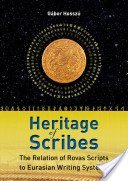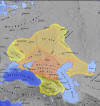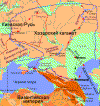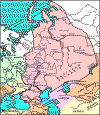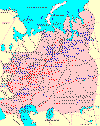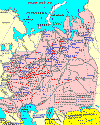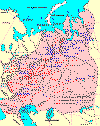| 141
7. The Khazar Rovas
7.1. Description of the script
7.1.1. General properties
The Khazar Rovas (KR) script is directed exclusively from right to left; there is no casing and no numerals in any of the known
Khazar Rovas relics. In some cases, borrowing characters from other scripts led to the multiplication
(duplication) of KR characters (Sec. 3.5.2). Sporadically and not consequently, KR applied vowel harmony in case of some consonants
(front consonants used with front vowels, back consonants used with back
vowels, i.e. ki vs. ɣï (ɣı), qï (qı)).
7.1.2. Khazar Rovas characters
Table 7.1.2-1 details the character repertoire of KR. The number of occurrences of each glyph in each relic is given in brackets at the end of the rows. In the first column the glyphs of the normalized
Khazar Rovas characters are listed according to the international standard proposal of the Hungarian Standards Institution.468
The notations like the following “in As-Alan, in
lig.,
sound: /a/ (4)” must be viewed critically, for example:
1. As-Alan attribution is frivolous, unjustified, of notional character. Genetic analysis of similar
claims demonstrated no connection between imagined “As-Alan” and the people buried.
2. The presumption of widespread ligatures in reality stands for “we do not know”
3. Accordingly, the phonetic value may be incorrect
4. The phonetic value must be consistent with the morphology of the script
5. Attribution to “As-Alan” is unprovable because there are no known examples of “As-Alan” language
in space and time.
Ditto with attributions Khazar, Kipchak, Ogur, etc. Ditto with dating, none of which is
instrumental and all of which are of notional character. In the sources, all attributions and datings
are preceded by qualifiers like “probably”, “possibly”, “likely”, and such, and those that are not
qualified deserve even less credibility. The proposed reading is erroneous if a scholar needs a
ligature for the reading, unless a bi-lingual inscription dictates a suspicion of a ligature.
We do expect ligatures in medallions, monograms and signet rings, since they are artistic
representations of the desired legend, and are strictly compliant. |
Table 7.1.2-1: KR characters and examples of each glyph in relics
| Glyph |
Name |
IPA symbol |
Examples of the Khazar Rovas glyph in relics |
| Y |
FORKED
A |
/a/ɛ/ |
Village
Krivy.,
Sec.
7.2.7, in
As-Alan, in
lig.,
sound: /a/ (4)
Ermen Tolga, Sec. 7.2.12, in Khazar, sound: /a/ɛ/ (6)
Mayak Large, Sec. 7.2.9, in Khazar, in lig.,
 sound: /a/ (3) sound: /a/ (3)
Mayak Smaller inscriptions, 9th c., Fig. 7.2.10-1,5a, in Khazar, partly in ligature, sound: /a/ (2)
Mayak Smaller, 9th c.,
Fig. 7.2.10-3, in As-Alan, in ligature, sound: /a/ (1) |
| X |
B |
/b/ |
Homokmegy-Halom, 10th c., Sec. 7.2.13, in Turkic (1)
Mayak Smaller Inscr., 9th c., Fig. 7.2.10-2, in Ogur (1) |
 |
ANGLED B |
/b/ |
Jitkov, first third of 8th c., Sec. 7.2.1, in Khazar (3)
Achiktash, first half of the 8th c., Sec. 7.2.4, in Kypchak (2)
Khumara, 9th—10th c., Fig. 7.2.5-3, in Khazar (1)
Novocherkassk, 9th—10th c., Sec. 7.2.6, in Kypchak (1)
Village Krivyanskoe, 9th— 10th c., Sec. 7.2.7, in As-Alan (1)
Ermen Tolga, 8th—10th c., Sec. 7.2.12, in Khazar (8)
Mayak Smaller, 9th c„ Fig. 7.2.10-1,5a,b, in Khazar (2)
Bilyar, 11th- 13th c., Sec. 7.2.16, in Ogur (l) |
 |
ARCHED B |
/b/p/ |
Jitkov, Bow Cover, 8th c., Sec. 7.2.1, in Khazar, sound: /b/ (1)
Mayak Large, 9th c., Sec. 7.2.9, in Khazar, sound: /p/ (1) |
 |
RAISED B |
/b/ |
Khumara, 9th—10th c., Fig. 7.2.5-4, in Ogur (1)
Alsoszentmihâlyfalva, 920-952 AD, Sec. 7.2.14, in Khazar (1)
Mayak Large Inscr., 9th c., Sec. 7.2.9, in Khazar (4)
Mayak Smaller, 9th c., Fig. 7.2.10-3, in As-Alan, in lig. (1) |
 |
TRIPLE CS (SH/S) |
/tʃ/s/ |
Achiktash, first half of the 8th c., Sec. 7.2.4, in Kypchak (4)
Khumara, 9th—10th c., Fig. 7.2.5-4, in Ogur, in ligature (1)
Village Krivyanskoe, 9th -10th c., Sec. 7.2.7, in As-Alan (3)
Mayak Large, 9th c., Sec. 7.2.9, glyph:
 ,
in Khazar (1) ,
in Khazar (1) |
 |
ARCHED D |
/d/di/dɛ/j/dʒ/ |
Jitkov, first third of 8th c., Sec. 7.2.1, in Khazar (2)
Achiktash, first half of the 8th c., Sec. 7.2.4, in Kypchak (1)
Khumara, 9th-10th c., Fig. 7.2.5-lb,2b, in Khazar (3)
Khumara, Fig. 7.2.5-4, in Ogur, sound: /di/, in lig. (1)
Novocherkassk, 9th-10th c., Sec. 7.2.6, in Kypchak (1)
Village Krivyanskoe, Sec. 7.2.7, in As-Alan, in lig. (2)
Alsöszentmihâlyfalva, 10th c., Sec. 7.2.14, in Khazar, sound: /ed/, in ligature (1)
Ermen Tolga, Sec. 7.2.12, in Khazar, partly in ligature (6)
Mayak Large, 9th c., Sec. 7.2.9, in Khazar, partly in lig. (8)
Mayak Smaller, Fig. 7.2.10-1, in Khazar, in ligature (1)
Mayak Smaller inscr., 9th c., Fig. 7.2.10-3, in As-Alan (1) |
 |
FORKED D |
/d/ |
Homokmegy-Halom, 10th c., Sec.
7.2.13, in Turkic (1) |
 |
SHARP D |
/d/ð/dʒ/
(There is a large semantical difference between /d/ and /ð/, in English /ð/ is transmitted as th,
which comes in voiced and unvoiced veriety. The Türkic /ð/ is transcribed as d or δ, apparently
depicting only a voiced version. In the early Horesmian Türkic alphabet the interdental th /ð/ was
depicted as
 , identical to the Futhark Þþ, which stands for voiced and unvoiced th.
This cardinally changes transcription: Ishad becomes Ishath)
, identical to the Futhark Þþ, which stands for voiced and unvoiced th.
This cardinally changes transcription: Ishad becomes Ishath) |
Jitkov, first third of 8th c., Sec. 7.2.1, in Khazar (3))
Achiktash, first half of the 8th c., Sec. 7.2.4, in Kypchak (7)
Mayaki Amphora, c., Sec. 7.2.2, in Ogur (1)
Devitsa Coins, 8lh-9th c., Sec. 7.2.3, in Khazar, in ligature (2)
Khumara, ca. 9th— 10lh c., Fig. 7.2.5-lb,2b,3, in Khazar (5)
Khumara, 9th—10lh c., Fig. 7.2.5-4, in Ogur (1)
Novocherkassk, 9th—10th c., Sec. 7.2.6, in Kypchak (3)
Village Krivyanskoe, 9th—10th c., Sec. 7.2.7, in As-Alan (3)
Minusinsk, 8th-9th c., Sec. 7.2.8, in Turkic (1)
Bilingual Khazar Coin, Sec. 7.2.11, in Khazar, in ligature (1)
Ermen Tolga, 8th—10th c., Sec. 7.2.12, in Khazar (1)
Mayak Large Inscr., 9th c., Sec. 7.2.9, in Khazar (6)
Mayak Smaller, 9th c., Fig. 7.2.10-1, in Khazar (1)
Mayak Smaller, Fig. 7.2.10-2, sound: /dʒ/, in Ogur (1)
Kievan Letter, 955-961, Sec. 7.2.15, in Khazar (1)
Bilyar, 11th-13th c.,Sec. 7.2.16, in Ogur (l) |
 |
DIAGONAL E |
/ɛ/ |
Mayaki Amphora, 8th-9th c., Sec. 7.2.2, in Ogur (1)
Khumara, 9th -10th c., Fig. 7.2.5-2b,3, in Khazar, glyph:
 (2)
(2)
Mayak Large, 9th c., Sec. 7.2.9, in Khazar, glyph:
 (2)
(2) |

|
ANGLED E |
/ɛ/ |
Achiktash, first half of the 8,h c., Sec. 7.2.4, in Kypchak (2) |
 |
ARCHED E |
/a/a:/ɛ/ |
Jitkov, 8th c., Sec. 7.2.1, in Khazar, glyph:
 ,
sound: /a/a:/ɛ/ (5) ,
sound: /a/a:/ɛ/ (5)
Khumara, Fig. 7.2.5-1b, 2b, 3, in Khazar, sound: /a/ (5) |
 |
FORKED E |
/a/ɛ/ |
Novocherkassk, Sec. 7.2.6, in Kypchak, sound: /a/ɛ/ (3)
Alsöszentmihâlyfalva, Sec. 7.2.14, in Khazar, sound: /a/ (1) |
 |
CLOSE E |
/e/ |
Achiktash, first half of the 8lh c., Sec. 7.2.4, in Kypchak (1) |
 |
CENTRAL F |
/f/ |
Village Krivyanskoe, 9th— 10th c., Sec. 7.2.7, in As-Alan (1) |
 |
CLOSE G |
/g/ɣ/ |
Achiktash, 8th c., Sec. 7.2.4, in Kypchak, sound: /g/ (1)
Khumara, 9,h—10th c., Fig. 7.2.5-1b, 2b in Khazar, sound: /g/ (3)
Minusinsk, 8th-9th c., Sec. 7.2.8, in Turkic, sound: /g/ (3)
Homokmegy-Halom, Sec. 7.2.13, in Turkic, sound: /ɣ/ (1)
Ermen Tolga, 8th—10th c., Sec. 7.2.12, in Khazar, sound: /g/ (1)
Mayak Large, 9th c., Sec. 7.2.9, in Khazar, sound: /g/ (6) |
 |
FORKED G |
/g/ |
Khumara, 9th— 10th c., Fig. 7.2.5-4, in Ogur (1) |
| N |
GH |
/ɣ/
in As-Alan languages: /g/ |
Jitkov, 8th c., Sec. 7.2.1, in Khazar:
 , sound: /ɣ/ (3) , sound: /ɣ/ (3)
Achiktash, Sec. 7.2.4, in Kypchak, glyph:
 , sound:
/ɣ/ (1) , sound:
/ɣ/ (1)
Mayaki, Sec. 7.2.2, in Ogur, calligr., mirrored
 , sound:
/ɣ/ (1) , sound:
/ɣ/ (1)
Khumara, 9th— 10th c., Fig. 7.2.5-2b,3, in Khazar, mirrored:
 , sound:
/ɣ/ (3) , sound:
/ɣ/ (3)
Khumara, Fig.
7.2.5-4, in Ogur, mirrored:
 , sound:
/ɣ/ (1) , sound:
/ɣ/ (1)
Village Krivyanskoe, Sec. 7.2.7, in As-Alan, mirrored:
 , sound:
/g/ (1) , sound:
/g/ (1)
Minusinsk, Sec. 7.2.8, in Turkic, mirrored:
 , sound:
/ɣ/ (1) , sound:
/ɣ/ (1)
Alsöszentmihâlyfalva, 10th c., Sec. 7.2.14, in Khazar, in ligature, sound: /ɣ/ (1)
Mayak Large, 9th c„ Sec. 7.2.9, in Khazar, sound: /ɣ/ (2)
Kievan Letter, 955-961, Sec. 7.2.15, in Khazar, sound: /ɣ/ (1) |
 |
TRIPLE GH |
/ɣ/ |
Minusinsk, 8th-9lh c., Sec. 7.2.8, in Turkic, overwritten (2)
Homokmegy-Halom, 10th c., Sec.
7.2.13, in Turkic (2) |
 |
ANGLED CH (KH) |
/x/ |
Mayaki Amphora, c., Sec. 7.2.2, in Ogur (1) |
 |
ARCHED CH (KH) |
/x/ |
Village Krivyanskoe, 9th-10th c., Sec. 7.2.7, in As-Alan (1) |
 |
FORKED CH (KH) |
/x/ |
Jitkov, Bow Cover, 8lh c., Sec. 7.2.1, in Khazar, glyph:
 (1) (1)
Mayak Large Inscr., 9th c., Sec. 7.2.9, in Khazar (1) |
 |
SHARP CH (KH) |
/h/ |
Achiktash, 8th c., Sec. 7.2.4, in Kypchak, sound: /h/ (4) |

|
ANGLED I |
/i/, in ligature also /e/ |
Jitkov, Sec. 7.2.1, in Khazar, mirrored glyph (1)
Mayaki Amphora, 8lh-9th c., Sec. 7.2.2, in Ogur (1)
Khumara, 911—10th c., Fig. 7.2.5-4, in Ogur, in lig., mirrored (1)
Mayak Large, Sec. 7.2.9, in Khazar, in lig., sound: /e/ (1)
Mayak Smaller, Fig. 7.2.10-4, in As-Alan, in lig. (1)
Ermen Tolga, Sec. 7.2.12, in Khazar, in ligature, sound: /e/ (3)
Alsöszentmihâlyfalva, 10th c., Sec. 7.2.14, in Khazar, in ligature, sound: /e/ (3)
Kievan Letter, Sec. 7.2.15, in Khazar in lig., mirrored (2) |

|
ARCHED I |
/i/ï/ |
Achiktash, first half of the 8th c., Sec. 7.2.4, in Kypchak (4)
Khumara, Fig. 7.2.5-2b, 3, in Khazar, partly in ligature, (2)
Village Krivyanskoe, 9lh— 10th c.,
Sec. 7.2.7, in As-Alan (2)
Mayak Large Inscr., 9th c„ Sec. 7.2.9, in Khazar (4)
Mayak Smaller, Fig. 7.2.10-2, in Ogur, mirrored:
 (1) (1)
Mayak Smaller. Fig. 7.2.10-5a,b, in Khazar, glyph:
 (1) (1) |
 |
CIRCLE ENDED I |
/i/ï/ |
Khumara, 9th— 10th c., Fig. 7.2.5-lb, in Khazar, glyph:
 (1) (1)
Khumara, 9th— 10th c., Fig. 7.2.5-4, in Ogur (1)
Minusinsk, 8th-9,h c., Sec. 7.2.8, in Turkic, glyph:
 (2) (2)
Ermen Tolga, 8th— 10th c., Sec. 7.2.12, in Khazar (1) |
 |
CLOSE J |
/j/ |
Jitkov, First third of 8th c., Sec. 7.2.1, in Khazar (1)
Achiktash, first half of the 8th c., Sec. 7.2.4, in Kypchak (1)
Khumara, 9th-10th c., Fig. 7.2.5-2b,3, in Khazar, glyph:
0
(2)
Alsöszentmihâlyfalva, 920-952, Sec. 7.2.14, in Khazar (2)
Minusinsk, 8lh-9lh c., Sec. 7.2.8, in Turkic (2)
Mayak Smaller, 9th c., Fig. 7.2.10-1, in Khazar (1)
Mayak Smaller, 9th c., Fig. 7.2.10-4, in As-Alan, in lig. (1) |
 |
FORKED K |
/k/ |
Jitkov, first third of 8th c., Sec. 7.2.1, in Khazar, in ligature (1)
Bilingual Khazar Coin, Sec. 7.2.11,
 , in Khazar (1) , in Khazar (1)
Mayak Smaller, 9th c., Fig. 7.2.10-4, in As-Alan (1)
Kievan Letter, 955-961, Sec. 7.2.15, in Khazar (1) |
 |
KUE |
/ky/ |
Alsöszentmihâlyfalva, 920-952, Sec. 7.2.14, in Khazar (1) |
 |
ARCHED L |
/l/ |
Khumara, 9th- 10th c., Fig. 7.2.5-4, in Ogur (1) |
 |
CROSSED L |
/l/ |
Homokmegy-Halom, 10th c., Sec. 7.2.13, in Turkic (1) |
 |
FORKED L |
/l/ |
Minusinsk, 8lh-9th c., Sec. 7.2.8, in Turkic (1) |
 |
SIMPLE L |
/l/ |
Achiktash, first half of the 8th c., Sec. 7.2.4, in Kypchak (1)
Mayak Large inscr., 9th c., Sec. 7.2.9, in Khazar (2)
Alsöszentmihâlyfalva, Sec. 7.2.14, in Khazar, in lig. (1)
Kievan letter, 955-961, Sec. 7.2.15, in Khazar in lig.(1) |
 |
LT |
/lt/ |
Mayak Large inscr., 9th c., Sec. 7.2.9, in Khazar (2) |
 |
OPEN M |
/m/ |
Achiktash, first half of the 8th c., Sec. 7.2.4, in Kypchak (2)
Mayaki Amphora, 8th-9lh c., Sec. 7.2.2, in Ogur (1)
Khumara, 9 — 10,h c., Fig. 7.2.5-2b,3, in Khazar (4)
Minusinsk, 8th-9th c., Sec. 7.2.8, in Turkic (2)
Bilingual Khazar Coin, Sec. 7.2.11, in Khazar (1)
Ermen Tolga, 8th— 10th c., Sec. 7.2.12, in Khazar, mirrored:
 (4) (4)
Mayak Large Inscr., 9th c., Sec. 7.2.9, in Khazar (2)
Mayak Smaller Inscr., 9th c., Fig. 7.2.10-2,, in Ogur, mirrored:
 (1) (1)
Mayak Smaller, Fig. 7.2.10-4, in As-Alan, mirrored:
 (2) (2) |
 |
ROUND M |
/m/ |
Novocherkassk, 9th— 10th c., Sec. 7.2.6, in Kypchak (2) |
 |
N |
/n/ |
Jitkov, first third of 8th c., Sec. 7.2.1, in Khazar (1)
Khumara, 9,h-10th c„ Fig. 7.2.5-2b, 3, in Khazar (3)
Homokmegy-Halom, 10th c., Sec. 7.2.13, in Turkic (2)
Mayak Large, 9th c., Sec. 7.2.9, in Khazar, partly, in lig. (5)
Mayak Smaller, 9lh c., Fig. 7.2.10-3, in As-Alan, in lig. (1)
Bilyar, 1 l,h-13th c„ Sec. 7.2.16, in Ogur(l) |
 |
ANGLED N |
/n/ |
Khumara, Fig. 7.2.5-lb,2b,3, in Khazar, glyph:
 (5)
(5)
Mayak Large Inscr., 9th c., Sec. 7.2.9, in Khazar (2) |
 |
FORKED N |
/n/ |
Achiktash, Sec. 7.2.4, in Kypchak, glyph:
 (2) (2)
Mayaki Amphora, 8th-9th c., Sec. 7.2.2, in Ogur, glyph:
 (4)
(4)
Khumara, 9th— 10th c., Fig. 7.2.5-3, in Khazar, glyph:
 (1)
(1)
Novocherkassk, 9th—10th c., Sec. 7.2.6, in Kypchak (1)
Stanitsa, 9th— 10th c., Sec. 7.2.7, in As-Alan, partly in lig. (4)
Mayak Smaller, 9th c., Fig. 7.2.10-1,5a,b, in Khazar (2)
Mayak Smaller, 9,h c., Fig. 7.2.10-3, in As-Alan (1) |
 |
NG |
/ŋ/ |
Ermen Tolga, 8th — 10th c., Sec. 7.2.12, in Khazar (1)
Mayak Large Inscr., 9th c., Sec. 7.2.9, in Khazar (2) |
 |
FORKED O |
/o/u/ |
Khumara, 9th-10th c„ Fig. 7.2.5-3, in Khazar (1)
Novocherkassk, 9th—10th c., Sec. 7.2.6, in Kypchak, glyph:
 (1)
(1)
Village Krivyanskoe, Sec. 7.2.7, in As-Alan, glyph:
 (6)
(6)
Mayak Large, Sec. 7.2.9, in Khazar, partly in lig.:
 (4)
(4)
Mayak Smaller, Fig. 7.2.10-5a,b, in Khazar, in lig. (1)
Kievan Letter, 955-961, Sec. 7.2.15, in Khazar (1) |
 |
P |
/p/ |
Achiktash, Sec. 7.2.4, in Kypchak, glyph: 3 (1) |
 |
SIMPLE P |
/p/ |
Jitkov, first third of 8th c., Sec. 7.2.1, in Khazar (2)
Khumara, 9th—10th c., Fig. 7.2.5-4, in Ogur (1)
Minusinsk, 8th-9,h c., Sec. 7.2.8, in Turkic (2) |
 |
ANGLED Q |
/q/uq/ |
Achiktash, 8th c., Sec. 7.2.4, in Kypchak, sound: /uq/ (2)
Homokmegy-Halom, Sec. 7.2.13, in Turkic, sound: /q/ (1) |
 |
ARCHED Q |
/q/ |
Mayak Smaller inscr., 9th c., Fig. 7.2.10-1, in Khazar (1) |
 |
OPEN Q |
/q/ |
Achiktash, first half of the 8th c., Sec. 7.2.4, in Kypchak (5) |
 |
CLOSE Q |
/q/ |
Alsöszentmihâlyfalva, 920-952, Sec. 7.2.14, in Khazar (1)
Mayak Large Inscr., 9th c., Sec. 7.2.9, in Khazar (1)
Mayak Smaller, 9th c., Fig. 7.2.10-5a,b, in Khazar (1)
Kievan Letter, 955-961, Sec. 7.2.15, in Khazar, in ligature (1) |
 |
R |
/r/ |
Mayaki Amphora, 8th-9th c., Sec. 7.2.2, in Ogur, glyph:
 (2)
(2)
Novocherkassk, Sec. 7.2.6, in Kypchak, in ligature (2)
Alsöszentmihâlyfalva, 920-952, Sec. 7.2.14, in Khazar (2)
Mayak Large, 9th c., Sec. 7.2.9, in Khazar, glyph:
 (2)
(2)
Mayak Smaller, Fig. 7.2.10-2, in Ogur, glyph:
 (1)
(1) |
 |
ARCHED R |
/r/ |
Achiktash, 8th c., Sec. 7.2.4, in Kypchak, glyph:
 (5)
(5)
Village Krivyanskoe, 9,h— 10th c., Sec. 7.2.7, in As-Alan (1) |
 |
CLOSE R |
/r/ |
Jitkov, first third of 8th c., Sec. 7.2.1, in Khazar (1)
Achiktash, first half of the 8th c., Sec. 7.2.4, in Kypchak (1)
Khumara, 9th—10th c., Fig. 7.2.5-lb,2b, in Khazar (2)
Khumara, 9th—10th c., Fig. 7.2.5-4, in Ogur (1)
Minusinsk, 8th-9th c., Sec. 7.2.8, in Turkic (3) |
 |
ARCHED SH |
/ʃ/ |
Mayak Large, 9th c., Sec. 7.2.9, in Khazar (1) |
 |
CIRCLE ENDED SH |
/ʃ/ |
Village Krivyanskoe, 9th-10th c., Sec. 7.2.7, in As-Alan (1) |
 |
ZS (SH) |
/ʃ/ |
Jitkov, first third of 8th c., Sec. 7.2.1, in Khazar (1)
Devitsa Coins, 8th-9th c., Sec. 7.2.3, in Khazar, in ligature (2)
Novocherkassk, 9th-10th c., Sec. 7.2.6, in Kypchak (3)
Ermen Tolga, 8th—10th c., Sec. 7.2.12, in Khazar (4) |
 |
SHL (SHL) |
/ɬ/ |
Bilyar, 1 l,h-13th c., Sec. 7.2.16, in Ogur (1) |
 |
SZ (S) |
/s/ |
Jitkov, first third of 8th c., Sec. 7.2.1, in Khazar (1)
Khumara, 9th-10th c„ Fig. 7.2.5-4, in Ogur (1)
Homokmegy-Halom, 10th c., Sec. 7.2.13, in Turkic (2)
Mayak Large Inscr., 9th c„ Sec. 7.2.9, in Khazar (2)
Mayak Smaller, 9th c., Fig. 7.2.10-4, in As-Alan (1) |
 |
FORKED SZ (S) |
/s/ |
Minusinsk, 8th-9th c., Sec. 7.2.S, in Turkic, simpler shape:
 (1) (1)
Khumara, 7.2.5-2b,3, in Khazar, simpler shape (2)
Krivyanskoe, 9th-10th c., Sec. 1.2.1, in As-Alan (1)
Mayak Large Inscr., 9th c., Sec. 1.2.9, in Khazar (1)
Mayak Smaller Inscr., 9th c., Fig. 1.2.10-2, in Ogur (1) |
 |
ARCHED T |
/t/ |
Khumara, 9th-10th c., Fig. 7.2.5-lb, in Khazar (1) |
 |
CENTRAL T |
/t/ |
Khumara, 9th-10,h c., Fig. 1.2.5-4, in Ogur (1)
Krivyanskoe, 9' -10th c., Sec. 1.2.1, in As-Alan (1)
Mayak Smaller Inscr., 9th c„ Fig. 1.2.10-2, in Ogur (1) |
 |
CLOSE T |
/t/ |
Bilyar, 11th-13th c., Sec. 1.2.16, in Ogur (1) |
 |
OPEN T |
/t/ |
Achiktash, 8th c., Sec. 1.2.4, in Kypchak (8)
Khumara, 9th—10lh c., Fig. 1.2.5-lb,2b, in Khazar (4)
Mayak Large, 9th c., Sec. 1.2.9, in Khazar, glyph:
 (1) (1)
Alsöszentmihâlyfalva, Sec. 1.2.14, in Khazar, in lig. (1) |
 |
ARCHED UE |
/ø/y/ |
Bilingual Khazar Coin, Sec. 1.2.11, in Khazar, partly in lig. (2)
Ermen Tolga, 8th—10th c., Sec. 1.2.12, in Khazar, glyph:
 (7) (7)
Mayak Large, 9th c., Sec. 1.2.9, in Khazar, glyph:
 (2) (2) |
 |
SHARP UE |
/ø/y/ |
Minusinsk, Sec. 1.2.8, in Turkic, glyph: N, sound: /y/ (3)
Khumara, 9th—10th c., Fig. 1.2.5-lb, 2b in Khazar, sound: /ø/ (2)
Alsöszentmihâlyfalva, Sec. 1.2.14, in Khazar, sound: /y/ (1) |
 |
OPEN V |
/β/,
in Common Turkic at the beginning of the word: /b-/,
in As-Alan: /v/ |
Mayaki Amphora, 8th-9th c., Sec. 1.2.2, in Ogur (1)
Novocherkassk, 9th—10th c., Sec. 1.2.6, in Kypchak (1)
Krivyanskoe, 9th— 10th c., Sec. 1.2.1, in As-Alan (2)
Bilingual Khazar Coin, Sec. 1.2.11, in Khazar (1)
Ermen Tolga, 8th— 10th c., Sec. 1.2.12, in Khazar (2)
Mayak Fortress Large, 9th c., Sec. 1.2.9, in Khazar (1) |
 |
CENTRAL Z |
/z/t/ |
Khumara, 9th—10th c., Fig. 1.2.5-3, in Khazar (1), sound: /z/
Krivyanskoe, Sec. 1.2.1, in As-Alan (1), sound: /z/
Minusinsk, Sec. 1.2.8, in Turkic (1), glyph:
 sound: /t/
sound: /t/ |
| |
|
|
         
    
         
           
            
                         |
468 Hosszu 2011, pp. 6-8 & 34-35
142, 143, 144, 145, 146, 147
In KR relics the OPEN
V denoted /β/b-/v/. In current Turkic languages, /β/ also exists. For instance, in the Turkish Latin-based orthography, the character v represents /β/ in some cases.469 OPEN
V denoted /β/b-/v/. In current Turkic languages, /β/ also exists. For instance, in the Turkish Latin-based orthography, the character v represents /β/ in some cases.469
7.1.3. Diacritic mark and punctuation
There is only one known Khazar Rovas diacritic mark (Table 7.1.3-1); its role is signifying the end of the word. There also exist punctuation marks in KR (Table 7.1.3-2).
469 Gökser & Kerlake 2005, pp. 6-7
147 Table 7.1.3-1: The diacritic mark of KR
| Glyph |
Name of the KR character |
Examples of the glyph in relics |
 |
COMBINING DOT ABOVE |
Novocherkassk, 9lh—10th c., Sec. 7.2.6, in Kypchak
Alsöszentmihâlyfalva, 920-952, Sec. 7.2.14, in Khazar |
Table 7.1.3-2: The Khazar Rovas separators and examples of each glyph in relics
| Glyph |
Name of the KR character |
Examples of the glyph in relics |
| • |
WORD SEPARATOR MIDDLE DOT |
Novocherkassk, 9th—10th c., Sec. 7.2.6, in Kypchak
Village Krivyanskoe, 9th—10th c., Sec. 7.2.7, in As-Alan
Minusinsk, 8th-9th c., Sec. 7.2.8, in Turkic
Alsöszentmihâlyfalva, 920-952, Sec. 7.2.14, in Khazar |
| : |
COLON |
Mayaki Amphora, 8th-9th c., Sec. 7.2.2, in Ogur
Ermen Tolga, 8th— 10th c., Sec. 7.2.12, in Khazar |
 |
TRICOLON |
Village Krivyanskoe, 9th— 10th c., Sec. 7.2.7, in As-Alan |
| ı |
WORD SEPARATOR VERTICAL BAR |
Khumara 9th -10th c., Fig. 7.2.5-1b, in Khazar |
 |
KHAZARIAN ROVAS
SEPARATOR LARGE |
Ermen Tolga, 8th— 10th c., Sec. 7.2.12, in Khazar
Minusinsk, Sec. 7.2.8, in Turkic with also a variant:

Mayak Large, 9th c., Sec. 7.2.9, in Khazar
Alsöszentmihâlyfalva, 920-952, Sec. 7.2.14, in Khazar |
7.1.4. Harmonization of consonants with vowels
The Khazar Rovas consonants are occasionally harmonized with the vowels of their syllables (Table 7.1.4-1). Oppositely to the Old Turkic consonants, this harmonization is not coherent.470 A consonant is called velar if it is used near back vowels, and it is called palatal if it is used near front vowels. The back (velar) and front (palatal) vowels are listed in
Table A-l. In some cases, the
Khazar Rovas characters of the velar-palatal consonant pairs were even exchanged, which is a unique feature of KR. Moreover, in the
Khazar Rovas inscription of the Mayaki Amphora (Sec. 7.2.2) the
 R /r/ was used in both velar and palatal syllables.
(R is neither velar, nor palatial, i.e. neutral consonant) R /r/ was used in both velar and palatal syllables.
(R is neither velar, nor palatial, i.e. neutral consonant)
Table 7.1.4-1: Examples of the consonants being harmonized and not harmonized with the vowels of their syllables
Harmonized with back (velar) vowels
(called velar consonants) |
Harmonized with front (palatal) vowels
(called palatal consonants) |
Examples |
 ARCHED
B /b/p/ ARCHED
B /b/p/ |
 ANGLED B /b/,
ANGLED B /b/, RAISED B /b/ RAISED B /b/ |
Jitkov, 8th c., Sec. 7.2.1, in Khazar
Mayak Large, 9th c., Sec. 7.2.9, in Khazar |
 ARCHED
D
/d/di/dɛ/j/dʒ/ ARCHED
D
/d/di/dɛ/j/dʒ/ |
 SHARP D /d/ð/dʒ/ SHARP D /d/ð/dʒ/ |
Jitkov, 8 c., Sec. 7.2.1, in Khazar
Mayak Large, 9th c., Sec. 7.2.9, in Khazar |
 , N GH /ɣ/ , N GH /ɣ/ |
 CLOSE
G /g/ CLOSE
G /g/ |
Achiktash, 8th c., Sec. 7.2.4, in Kypchak
Minusinsk, 8th-9th c., Sec. 7.2.8, in Turkic
Mayak Large, 9th c., Sec. 7.2.9, in Khazar |
| N GH /ɣ/ |
 FORKED
G /g/ FORKED
G /g/ |
Khumara, ca. 9th c., Fig. 7.2.5-4, in Ogur |
 N /n/ N /n/ |
 FORKED N /n/, FORKED N /n/, ANGLED N /n/ ANGLED N /n/ |
Khumara, ca. 9th c., Sec. 7.2.5, in Khazar
Mayak Large, 9th c., Sec. 7.2.9, in Khazar |
 CLOSE
R /r/ CLOSE
R /r/ |
 ARCHED R /r/ ARCHED R /r/ |
Achiktash, 8th c., Sec. 7.2.4, in Kypchak |
| (There is no occurrence in relics) |
 CLOSE
R /r/ CLOSE
R /r/ |
Minusinsk, 8th-9th c., Sec. 7.2.8, in Turkic |
| (There is no occurrence in relics) |
 , ,
 R /r/
R /r/ |
Mayak Smaller inscription, 9th c. Fig. 7.2.10-2, in Ogur
Alsöszentmihâlyfalva, Sec. 7.2.14, in Khazar |
 R/r/
R/r/ |
 R/r/
R/r/ |
Mayaki, 8th-9th c., Sec. 7.2.2, in Ogur |
 OPEN T /t/ OPEN T /t/ |
 ARCHED T /t/ ARCHED T /t/ |
Khumara, ca. 9th c., Sec. 7.2.5, in Khazar |
| (There is no occurrence in relics) |
 , ,  OPEN T/t/ OPEN T/t/ |
Achiktash, Fig. 7.2.4-1, in Kypchak
Minusinsk, Fig. 7.2.8-1, in Turkic
Mayak Large, Fig. 7.2.9-2, in Khazar |
470 Vekony 2004a, p. 193
148, 149
7.1.5. Ligatures
In Khazar Rovas, ligatures were frequently used. They are only stylistic, similarly to CBR ligatures (Sec. 6.1.5). However, two ligatures are systematic and used regularly
(Table 7.1.5-1):
 DA and DA and
 DI. The sound values of DI. The sound values of
 DI are /de/, /di/, and
/ed/. Surely, its constituents are DI are /de/, /di/, and
/ed/. Surely, its constituents are ARCHED D /d/ and ARCHED D /d/ and ANGLED I. This supports that the ANGLED I. This supports that the ANGLED I originally represented both /e/ and /i/, despite of the fact that in the surviving KR relics, the ANGLED I originally represented both /e/ and /i/, despite of the fact that in the surviving KR relics, the ANGLED I represented /i/ only. It is noteworthy that in the Old Turkic script, which is also a descendant of the Early Steppe script, similarly to KR, the Old Turkic ANGLED I represented /i/ only. It is noteworthy that in the Old Turkic script, which is also a descendant of the Early Steppe script, similarly to KR, the Old Turkic
 I represented both
/e/ and /i/ (Sec. 4.1). I represented both
/e/ and /i/ (Sec. 4.1).
Table 7.1.5-1: The systematic Khazar Rovas ligatures
| Glyph |
Name |
Transcription |
Constituents |
Examples of the glyph in relics |
 |
DA |
/da/ |
 ARCHED D
/d/ + ARCHED D
/d/ +
Y FORKED A /a/ |
Krivyanskoe, Sec. 7.2.7, in As-Alan, sound: /da/
Mayak Large, Sec. 7.2.9, in Khazar, sound: /da/
Mayak Smaller, Fig. 7.2.10-1, in Khazar, /da/ |
 |
DI |
/de/di/ed/ |
 ARCHED D
/d/ + ARCHED D
/d/ +
 ANGLED I
/i/e/ ANGLED I
/i/e/ |
Humara, Fig. 7.2.5-4, in Ogur, sound: /di/
Alsöszentmihâlyfalva, Sec. 7.2.14, in Khazar, /ed/
Ermen Tolga, Sec. 7.2.12, in Khazar, sound: /de/
Mayak Large, Sec. 7.2.9, in Khazar, sound: /de/ |
149
Table 7.1.5-2 presents the non-systematic Khazar Rovas ligatures being applied on occasion.
| Glyph |
Name |
Transcription |
Constituents |
Examples of the glyph in relics |
 |
AA |
/ʃi/, /iʃ/, /aa/ |
 FORKED
E /a/ + FORKED
E /a/ + FORKED E
/a/ FORKED E
/a/ |
Village Krivyanskoe, Sec. 1.2.1, in As-Alan |
 |
AN |
/an/ |
 ARCHED E /a/ + ARCHED E /a/ +
 N /n/ N /n/ |
Khumara, 9th—10th c., Fig. 1.2.5-3, in Khazar |
 |
ATLIGH |
/ətliɣ/ |
 OPEN
T /t/ + OPEN
T /t/ + SIMPLE
L /l/ + N GH /ɣ/ SIMPLE
L /l/ + N GH /ɣ/ |
Alsöszentmihâlyfalva, 920-952, Sec. 1.2.14, in Khazar |
 |
BAN |
/ban/ |
 RAISED
B /b/ + Y FORKED A /a/ + RAISED
B /b/ + Y FORKED A /a/ +
 N /n/ N /n/ |
Mayak Smaller inscription, 9th c., Fig. 1.2.10-3, in As-Alan |
 |
CSI (SHI) |
/tʃi/ |
 TRIPLE
CS (SH/S) /tʃ/ + TRIPLE
CS (SH/S) /tʃ/ +
 ANGLED I
/i/ ANGLED I
/i/ |
Khumara, 9th- 10th c., Fig. 1.2.5-4, in Ogur |
 |
DKE |
/ðkɛ/ |
 SHARP D
/ð/ + SHARP D
/ð/ +  FORKED K /k/ + FORKED K /k/ +
 ARCHED E /ɛ/ ARCHED E /ɛ/ |
Jitkov, first third of 8th c., Sec. 7.2.1, in Khazar |
 |
ER |
/ɛr/ |
 FORKED E
/ɛ/ + FORKED E
/ɛ/ +  R
/r/ R
/r/ |
Novocherkassk, 9th—10th c., Sec. 1.2.6, in Kypchak |
 |
IL |
/il/ |
 ANGLED I
/i/ (mirrored glyph) + ANGLED I
/i/ (mirrored glyph) +
 SIMPLE
L /l/ SIMPLE
L /l/ |
Kievan Letter, 955-961, Sec. 1.2.15, in Khazar |
 |
IN |
/ïn/ |
 ARCHED I /ï/
+ ARCHED I /ï/
+  FORKED
N /n/ FORKED
N /n/ |
Khumara, ca. 9th c., Sec. 1.2.5, in Khazar |
 |
IQ |
/ïq/ |
 ANGLED I
/i/ (mirrored glyph) + ANGLED I
/i/ (mirrored glyph) +
 CLOSE Q /q/ CLOSE Q /q/ |
Kievan Letter, 955-961, Sec. 1.2.15, in Khazar |
 |
JI |
/ji/ |
 CLOSE J /j/ + CLOSE J /j/ +
 ANGLED I
/i/ (mirrored glyph) ANGLED I
/i/ (mirrored glyph) |
Mayak Smaller inscription, 9th c., Fig. 1.2.10-4, in As-Alan |
 |
ISHAD |
/iʃað/ |
 ZS
(SH)
/ʃ/ + ZS
(SH)
/ʃ/ +  SHARP D
/ð/ SHARP D
/ð/ |
Devitsa Coins, c., Sec. 1.2.3, in Khazar |
 |
NI |
/ni/ |
 FORKED
N /n/ + FORKED
N /n/ +  ARCHED I /i/ ARCHED I /i/ |
Krivyanskoe, 9th— 10th c., Sec. 1.2.7, in As-Alan, ornamental |
 |
NU 1 |
/nu/on/ |
 FORKED
N /n/ + FORKED
N /n/ +  FORKED
O /u/ FORKED
O /u/ |
Krivyanskoe, Sec. 1.2.1, in As-Alan
Mayak Smaller inscription, 9th c., Fig. 1.2.10-5a,b, in Khazar |
 |
NU 2 |
/nu/ |
 N /n/
+ N /n/
+  FORKED
O /u/ FORKED
O /u/ |
Mayak Large, 9th c., Sec. 1.2.9, in Khazar |
 |
ON |
/on/ |
 FORKED
O /u/ + FORKED
O /u/ +
 N /n/ N /n/ |
Mayak Large, 9th c., Sec. 1.2.9, in Khazar |
 |
RAT |
/rat/ |
 CLOSE R /r/ + CLOSE R /r/ + ARCHED E /ɛ/
+ ARCHED E /ɛ/
+
 OPEN T
/t/ OPEN T
/t/ |
Khumara, ca. 9th c., Sec. 1.2.5, in Khazar |
 |
SI |
/sï/ |
 SZ
(S) /s/ + SZ
(S) /s/ + ANGLED
I /ï/ ANGLED
I /ï/ |
Achiktash, 8th c., Sec. 1.2.4, in Kypchak |
 |
SHID |
/ʃið/ |
 ZS
(SH)
/ʃ/ + ZS
(SH)
/ʃ/ + ANGLED
I /i/ + ANGLED
I /i/ + SHARP D
/ð/ SHARP D
/ð/ |
Achiktash, 8th c., Sec. 7.2.4, in Kypchak |
 |
TEGH |
/teɣ/ |
 OPEN
T /t/ + N GH /ɣ/ OPEN
T /t/ + N GH /ɣ/ |
Khumara, ca. 9th c., Sec. 7.2.5, in Khazar |
 |
UED |
/øð/ |
 ARCHED
UE /ø/ + ARCHED
UE /ø/ + SHARP D
/ð/ SHARP D
/ð/ |
Bilingual Khazar Coin, Sec. 7.2.11,
 in Khazar in Khazar |
150, 151
7.2. Relics of the Khazar Rovas
Map 7.2-1 presents the locations of KR archaeological finds in Eurasia. Most of the Khazar Rovas relics were found in the territory of the late Khazar
Kaganate, north of the Caucasus.
Map 7.2-1: Locations of the Khazar Rovas archaeological finds in Eurasia excluding the relics of the Carpathian Basin
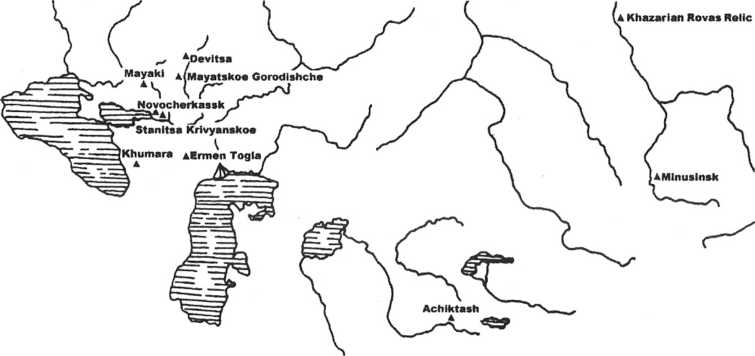
7.2.1. Bow Cover of Jitkov
In 1986, Y. I. Bespalyi found a horn cover for a bow with a Rovas inscription in burial No. 1 of kurgan No. 4 on the field Jitkov II in the Rostov region.471 The relic is dated by some coin finds. Among them, there is a dirham from Nahr Tira dated to 716-717, and a solidus of Leo III (ruled in 717-720). These coins date the burial to the first third of the 8lh century.472
471 Semenov 1988, p. 109
472 TürkicWorld, web site
151
Figure 7.2.1-1: The inscription on the bow cover found at Jitkov, first third of the 8th century473

Table 7.2.1-1: Transcription of the Jitkov Inscription, first third of the 8th century
| Written with normalized Khazar Rovas font (RTL) |
 |
|
Common Turkic (Khazar) (RTL
transcription) |
ekthib a xo ɣiyab ɣibe thib apaʒ n:aaraspa ɣaʒ shithi |
| IPA phonetic transcription (LTR transliteration) |
 |
| Translation from Common Turkic (Khazar) |
‘We send Apsar Jap [the] bow. Shoot a mansion, wealth, oh to us!’ |
The ligature DKE /ðkɛ/ is composed of the followings:  SHARP D
/ð/ + SHARP D
/ð/ +  FORKED K /k/ + FORKED K /k/ +
 ARCHED E /ɛ/. ARCHED E /ɛ/.
7.2.2. Mayaki Amphora Inscription in Ogur
The Mayaki Amphora Inscription was found in the motte-and-bailey
(citadel) of Mayaki, on the right bank of the Donets River. Its drawings were created by I. L. Kyzlasov
(Fig. 7.2.2-1 and 2). The amphora was made in the 8 - 9th centuries, when the fortress was used.
Figure 7.2.2-1: The Mayaki Amphora Inscription, 8th-9th centuries474
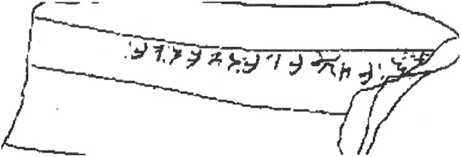
Figure 7.2.2-2: Another drawing of the Mayaki Amphora Inscription475 On this relic, the glyph
 R /r/ - a variant of the
R /r/ - a variant of the  R /r/ was used. R /r/ was used.

Table 7.2.2-1: The transcription of the inscription on the Mayaki Amphora
| Written with normalized Khazar Rovas font (RTL) |
 [unreadable] [unreadable] |
|
Common Turkic (Khazar) (RTL
transcription) |
nob meriʒ nï naɣax rana |
| IPA phonetic transcription (LTR transliteration) |
 |
| Translation from Ogur |
‘(This is) of Kagan Nar [or Anar], Twenty won.' |
473 Semenov 1988, p. 108
474 Klyashtomy 1979
475 Klyashtomy 1979
152
The Ogur word won was a measurement unit. The first two characters of the inscription were damaged; their transcription presumably is
bu. The name Nar (or Anar) was an ancient Turkic personal name.476 Since the transition /q/ > /x/ had been completed by the beginning of the 10th century in Ogur,477 the use of the word /xaɣan/ instead of the /qaɣan/ is explicable in the inscription.
The Oguz tribes moved into the Aral neighborhood at about 750, absorbing a spectrum
of the local
tribes known under a collective name Alans (Field or Steppe People, Polyans in Slavic) who were big on /h/ (/x/), it can
be expected that both the local version /xaɣan/ and the Oguz version /qaɣan/ remained in circulation
through the 10th c. and way beyond. The Arab (Moslem) writers used the form /xaɣan/, because that
form was used by the southwestern tribes they first encountered, or that was an Arabicized form due to
the specifics of the Arab phonetics. Either way, a quasi-scientific presumption on codified single
Oguz language, and the assertion that the blend of the local and migrant tribes spoke a common Oguz
language without dialectal differences, are pretentious fallacies. The -h- dialect of the
Aral basin followed Alans across Europe to Africa, and is prominant in the New World under a name
Castilian (Castellano) of the Argentinian Spanish.
|
7.2.3. The Devitsa Coins
In 1939, the Devitsa (also called Devica) treasure was found near the Don River. It contains 237 coins. According to Bykov, these coins are Khazar products
478 and their origin is between 754 and 811/812.479 This opinion is supported by scholars, especially Ludwig480 and Bâlint481
On several coins, the same ligature can be observed (Table 7.2.3-1)482
It means Ishad /iʃað/, the alternate name of the vice-king Ilik (i.e. Ulug,
aka Yilig, a short for Ulug-Bek, aka Bek, aka Kagan-Bek, a title of a
Prime Minister at a presiding Kagan) of the Khazar Kaganate.483 This inscription authenticated the coins. According to Golden,
Ishad (a Göktürk military rank used among southeastern tribes) is a version of an Iranian
(Persian?) dignitary name (title?).484 Based on these finds, the word
Ishad was used in the 8th- early 9th centuries. However, the dignitary name Ilik was used later, in the 10th century. Besides
Ishad and Ilik, there was a third name of the vice-king, namely
/bɛk/; its other form was /beg/.485
Table 7.2.3-1: The ligature of the Devitsa Coins from the 8th-9lh centuries and its transcription
| Ligature on the Devitsa Coins (glyph variations) |
 |
| The elements of the ligature written with normalized Khazar Rovas font (RTL) |
 (SH)
/ʃ/
(SH)
/ʃ/  (I)
/i/ (I)
/i/ |
|
Common Turkic (Khazar) (RTL
transcription) |
Ishath |
| IPA phonetic transcription (LTR transliteration) |
/iʃað/ |
| Translation from Common Turkic (Khazar) |
‘Ishad’ |
Alternatively, the “ligature” was suggested to be a tamga of the ruler, in the Devitsa Hoard
of the Kagan Bulan (760-805), whose Beks were in sequence Bulan Sabriel (ca 740) and Obadia (ca
786-809). A name or a title-name of a subordinate minted on the coin would indicate a claim to
suzerainty and treated as a rebellion, an unlikely situation with two consecutive Beks under the
same
Kagan. Coin images (Fig. 21) and extracts from the table (Table 3) are cited from A.
Mukhamadiev, 2005, Ancient Coins of Kazan Kazan, Tatar Publishing house, ISBN 5-298-04057-8.
The highest title Ishad, if it was confirmed by any independent evidence, would be a major
step in figuring out the Khazar origin or provenance of the title. The title is peculiar to a
handful of Türkic principalities centered around Fergana area, and limited in time to a period of
few centuries before the Arab conquests.
| Images of the Khazar coins |
| Fig. 21. Khazar dirham |
Khazar coin - immitation |
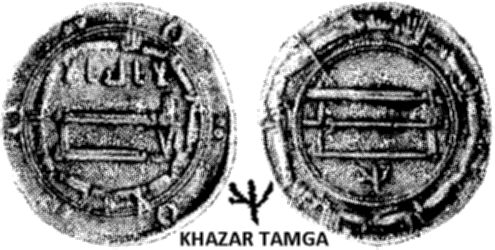 |
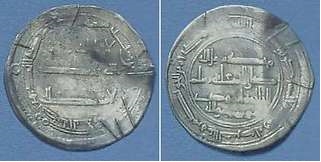 |
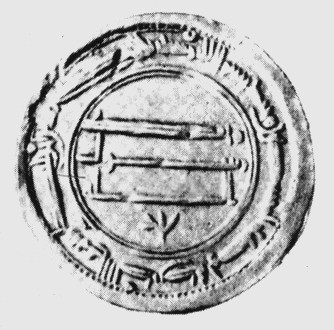 |
Khazar coin with Türkic runiform inscription
Found in Kaluga region (Central Russia) |
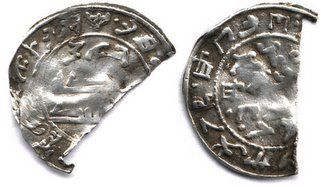 |
Türkic runes in the legend of this coin are not Orkhon or Enisei alphabet, but definitely from
Western areas (Southern Russia, Volga region, Northern Caucasus).
Attribution: Itil Bulgar or Khazar Kaganate (?), 9-10th c. (?) |
Table 3
Khazar imitations (Devitsky hoard)
| Coin type |
Coin dates |
Dating mark on reverse |
Reign years of rulers and existence of symbols |
Qty of coins |
Kagan and Bek |
Tamga |
| VIII |
150/767-68 |
Symbol of creed in two circles |
136-158 |
754-775 |
1 |
Bulan (760-805)/Bulan Sabriel (ca 740) |
 |
| IX |
150/767-68 |
Ditto |
136-158 |
754-775 |
1 |
Bulan (760-805)/Bulan Sabriel (ca 740) |
 |
| X |
150/767-68 |
al-Mahdi as heir |
145-158 |
762-63-775 |
1 |
Bulan (760-805)/Bulan Sabriel (ca 740) |
 |
| XI |
150/767-68 |
Zur-p-riyasatain (Fadl ibn Sahl) |
196—205 |
811-12-820-21 |
38 |
Bulan (760-805)/Bulan Sabriel (ca 740) |
 |
| XII |
162/778-79 |
Symbol of creed in two circles |
136-158 |
754-775 |
1 |
Bulan (760-805)/Obadia (ca 786-809) |
 |
| |
837/838 |
Symbol of creed Musa rasul Allah “Moses is the Messenger of God” |
|
|
5 |
|
— |
|
|
476 Vekony 2004a, p. 272
477 Rona-Tas 1982b, pp. 163-164
478 Bykov 1971, pp. 26-35
479 Bykov 1971, pp. 65-66
480 Ludwig 1982, p. 274
481 Bâlint 1980, p. 384; Bâlint 1981. p. 410
482 Shake 2000, p. 35; Kovalev 2004, p. 113
483 Vekony 1997a, p. 28
484 Golden 1980, pp. 206 208
485 Golb & Pritsak 1982
153
7.2.4. The Achiktash Inscription from the Talas Valley in Kypchak
Fig. 7.2.4-1 presents the Achiktash Inscription (Wooden Stick of Talas) from the first half of the 8th century.
See
Codex_EuroAsiaticAchiktash_En.htm for details. The stick, buried under 5 m of soil in a well of
an old mine, should be associated with the mining population of the time, which for millennia is
anchored down by the deposits, and lives through all regimes. The mine bore tests showed 57% Fe, 4%
Cu, and 1% S, hence look for the iron-smith locals right on the main trace of the Silk Road (Ian
Blanchard, 2001, Mining, Metallurgy and Minting in the Middle Ages: Asiatic supremacy, Franz
Steiner Verlag, ISBN 9783515079587). The association with Kipchaks is more than dubious, but the
Saka Piedmonter tribes of the Türks, known as iron-smiths from the Chinese annals, are quite suitable (till the C14
analysis of the stick and the mine). The geographically nearest runiform inscriptions are the Issyk inscription
(4th c. BC) and Kultobe inscribed ceramic bricks of standard Middle Asian type 27x27x6 cm (4th-1st
cc. BC).
Issyk
 |
Kultobe
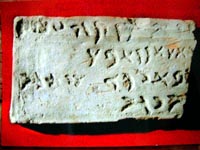
|
|
Figure 7.2.4-1: The Achiktash Inscription (first half of the 8th c.)486
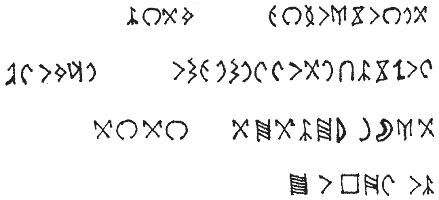
The inscription is on the four sides of a wooden stick. The stick was broken into three parts, but the middle one was never found. Therefore, the middle part of the text in each row is missing; the transcription is shown in Table 7.2.4-1
487 According to Vekony, the occasion for creating the inscription was probably the accession of a new ruler to the throne.488
In the inscription, the glyph
 - a variant of the - a variant of the  ARCHED R /r/ and the glyph ARCHED R /r/ and the glyph
 - a mirrored variant of the
- a mirrored variant of the  FORKED N /n/ were used. The glyph FORKED N /n/ were used. The glyph
 was normalized as was normalized as  P /p/. P /p/.
Table 7.2.4-1: Transcription of the Achiktash Inscription
| Written with normalized Khazar Rovas font (RTL) |
 |
|
Common Turkic (Khazar) (RTL
transcription) |
[thïgn(ɛ)ï]hrïtïb
poq thibithihsi
[gnïna]t rɛtrɛ |
|
...nirø ethe quthï riT
...thim nïmïqo qïthti edih quɣthaQ
...tyso thus ja ligeT
ïsuthu rasaq thiH |
|
| IPA phonetic transcription (LTR transliteration) |
 |
| Translation from the Kypchak |
‘He says: the throne of the holy dominus you write [singular or plural] We ... reading the written stick sent by you we all heard it Ay! Say it: Sogdian vengeance ... avoid [you], [you] k[now] You, Khazars. Good (= true, credible). End.’ |
Ay was a personal name meaning ‘Moon’ in Proto-Turkic (what
“Proto-Turkic” means?). In the fourth row, the name Khazar is found:
 /qasar/ ‘Khazar’ and the name of the Sogdians is in the third row: /qasar/ ‘Khazar’ and the name of the Sogdians is in the third row:
 /suht/ ‘Sogdian’. Vekony supposed that in this inscription, the KR /suht/ ‘Sogdian’. Vekony supposed that in this inscription, the KR
 TRIPLE CS
(SH/S) /tʃ/ represents /s/.489 This is possible, if the /tʃ/ > /s/ change happened in the language of this inscription. For instance, such a transition occurred in the Bashkir language.490 TRIPLE CS
(SH/S) /tʃ/ represents /s/.489 This is possible, if the /tʃ/ > /s/ change happened in the language of this inscription. For instance, such a transition occurred in the Bashkir language.490
486 Vekony 2004a, p. 287
487 Vekony 1986, Fig. 1
488 Vekony 2004a, p. 293
489 Vekony 2004a, p. 294
490 Vâsâry 2010-2011
154
7.2.5. The Khumara building inscriptions
Khumara is an old Khazar fortress on the right hand side of the Kuban River, currently in the Karachay-Cherkess Republic (Russia). The Khumara Fortress was near to a very important road, which was the main artery between Khwarezm and Byzantium in the Early Medieval Times.491 The total area of the huge fortress was a quarter km2, the total length of its walls reached 1900 meters. A.V. Gadlo showed that the fortress was built in the beginning of the 8th century.492 Fig 7.2.5-1 a presents the photograph of a building inscription on a sandstone block found in 1962, and Fig.
7.2.5-lb shows its drawing. The original stone was re-used for the construction of the fortification wall and it was broken into two pieces. The origin of the inscription is between the mid-9,h century and beginning of the 10th century.493
Figure 7.2.5-la: Photograph of the One-row Inscription on a fragment of a sandstone block, between middle of the 9th and 10th centuries494

Figure 7.2.5-lb: Drawing of the One-row Inscription495

Table 7.2.5-1: Transcription of the One-row Khazar Rovas Inscription of Khumara
| Written with normalized Khazar Rovas font (RTL) |
 |
|
Common Turkic (Khazar) (RTL
transcription) |
ïtarad niget thø |
| IPA phonetic transcription (LTR transliteration) |
 |
| Translation from Common Turkic (Khazar) |
‘Öd Tegin made [it].’ |
The word  /darati/ is the ancestor of the Hungarian word
gyârt /da:rt/ ‘produce, make’. The Öz /øz/ is a well-known Turkic personal name.496 According to Vekony, the transition
/z/ > /ð/ (/th/) happened in Khazar. Therefore, Öd /øð/
(/öth/) was identical with Öz /øz/. The /tegin/
(Prince) was a Khazar title (dignitary name). There is an example for this dignitary name in the sources: the name “Er Tegin” from the 680s.497 In the Western Turkic
Kaganate, the title tegin was also used, as it is attested to in inscriptions found in East Iran.498 The word
tegin survived as a personal name in the 10th century: a leader of the Magyars was called Teteny (its other form:
Tühütüm).499 This name can be found in the name of
Teteny Village (present-day Tadten in Burgenland, Austria) near the Lake Ferto, in the name of
Tattendorf 'Tatten Village’ (present-day east of Vienna, Austria) near the Triesting River, and in the name of Budapest District 22: Nagyteteny ‘Great Teteny’.500 /darati/ is the ancestor of the Hungarian word
gyârt /da:rt/ ‘produce, make’. The Öz /øz/ is a well-known Turkic personal name.496 According to Vekony, the transition
/z/ > /ð/ (/th/) happened in Khazar. Therefore, Öd /øð/
(/öth/) was identical with Öz /øz/. The /tegin/
(Prince) was a Khazar title (dignitary name). There is an example for this dignitary name in the sources: the name “Er Tegin” from the 680s.497 In the Western Turkic
Kaganate, the title tegin was also used, as it is attested to in inscriptions found in East Iran.498 The word
tegin survived as a personal name in the 10th century: a leader of the Magyars was called Teteny (its other form:
Tühütüm).499 This name can be found in the name of
Teteny Village (present-day Tadten in Burgenland, Austria) near the Lake Ferto, in the name of
Tattendorf 'Tatten Village’ (present-day east of Vienna, Austria) near the Triesting River, and in the name of Budapest District 22: Nagyteteny ‘Great Teteny’.500
The speculation on /z/ > /ð/ (/th/) transition conflicts with attestation
that interdental th was widespread in the Old Türkic, depicted as δ in transcriptions,
and in the old Türkic Horesmian, depicted as
 and identical to the Futhark Þþ. Likely, the transition went in opposite way, the
alien speakers were adopting the Türkic th in a veriety of approximations, including /z/, /t/, /d/,
and /f/.
and identical to the Futhark Þþ. Likely, the transition went in opposite way, the
alien speakers were adopting the Türkic th in a veriety of approximations, including /z/, /t/, /d/,
and /f/.
|
491 Erdelyi 1983b, p. 264
492 Gadlo 1979, pp. 152-153
493 Baichorov 1989, p. 67, pp. 170-173; Türkic World, web site
494 Kuznetsov 1963, Fig. 2 -2
495 Vekony 1987a, p. 27; Vekony 2004b
496 Nadeljaev et al (ed.) 1969, p. 395
497 Golden 1980, pp. 186-187
498 Harmatta 1994, pp. 149-164
499 Györffy 1998, p. 135
155
Figure 7.2.5-2a: Photograph of Three-row Inscription from the Khumara fortress501
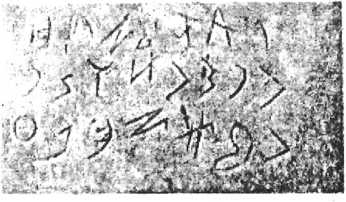
The meaning of the One-row Inscription in Fig. 7.2.5-1a matches the first row of the inscription of the
Fig. 7.2.5-2a. In the first row of Fig. 7.2.5-2a, the second symbol
 on the left is a ligature of the characters on the left is a ligature of the characters  CLOSE
R /r/, CLOSE
R /r/, ARCHED E /a/,
and ARCHED E /a/,
and
 OPEN T
/t/. These characters were used as individual glyphs in Fig. 7.2.5-la. In the third row, the ligature OPEN T
/t/. These characters were used as individual glyphs in Fig. 7.2.5-la. In the third row, the ligature
 contains contains
 OPEN T
/t/ and N GH /ɣ/. OPEN T
/t/ and N GH /ɣ/.
In the word
 /teɣine/ there are
front vowels. However, in other parts of this Three-row Inscription, the /teɣine/ there are
front vowels. However, in other parts of this Three-row Inscription, the  CLOSE G /g/ was applied near
front vowels and another character N GH /ɣ/ is used near back vowels. The probable reason of this inconsistency is that CLOSE G /g/ was applied near
front vowels and another character N GH /ɣ/ is used near back vowels. The probable reason of this inconsistency is that OPEN T
/t/ and N GH /ɣ/ was easier to apply to create the ligature OPEN T
/t/ and N GH /ɣ/ was easier to apply to create the ligature
 . Another example for altering the velar and palatal consonants is the use of the velar . Another example for altering the velar and palatal consonants is the use of the velar OPEN T
/t/ in the first row instead of the palatal OPEN T
/t/ in the first row instead of the palatal ARCHED T /t/. It is noteworthy that in this case the ARCHED T /t/. It is noteworthy that in this case the OPEN T
/t/ was not used in ligature. To summarize, this inscription demonstrates the inconsistent use of the velar and palatal consonants in KR (Sect. 7.1.4). OPEN T
/t/ was not used in ligature. To summarize, this inscription demonstrates the inconsistent use of the velar and palatal consonants in KR (Sect. 7.1.4).
A tendency to blame scribes and carvers is a longstanding philological tradition. A
lazy carver may not be a culprit, though. Most of the time, a palatal syllable carries a different
meaning from the velar syllable, and to confuse them is akin to replacing red stripes with green
stripes on a national flag, that completely changes the message. A few words have two versions, one
with palatal phonetics, and the other with velar phonetics. Frequently, these few words also contain
neutral syllables, and can be swung either way. Absent that, different meanings should theoretically
be suspected for tegine /tegine/
and täkïnä /təkïnə/ before invoking a lazy carver. In the end, the
linguistic and phonetical attributions of the carvings and the use of ligatures are conditional on
what is not known.
|
Figure 7.2.5-2b: Drawing of the Three-row Inscription502
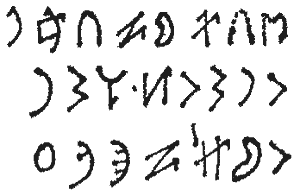
500 Bartha 1984, p. 577; Györtly 1998, p. 135; Zelliger 2010-2011
501 Kuznetsov 1963, Fig. 2-2
502 Vekony 2004b
156
Table 7.2.5-2: Transcription of the Three-row Inscription of Khumara
| Written with normalized Khazar Rovas font (RTL) |
 |
|
Common Turkic (Khazar) (RTL
transcription) |
ïtarad niget dø
namsa ɣïthïmïnïth
øthyg eniɣet ja |
| IPA phonetic transcription (LTR transliteration) |
 |
| Translation from Common Turkic (Khazar) |
‘Öd Tegin (had it) made our nest [=home], As(es). Call it Ödüg Tegin.' |
Table 7.2.5-2: Transcription of the Three-row Inscription of Khumara
The drawing in Fig. 7.2.5-3 was made by the student A.D. Besleneev on his summer holiday; hence, its accuracy is possibly limited. There is no photograph of the original relic, since it was destroyed before the arrival of the archaeologists.503 In the inscription, the glyph
0 is a variant of D CLOSE J /j/. The word /aj/ means ‘speak, say, call’ in Turkic. The word /*asman/ probably mean ‘As’ or ‘Ases’, since /as/ was the name of the As-Alans and /man/ is a Turkic affix emphasizing the meaning (nation or tribe name).
(It could also mean various types of rams, like a castrated ram; the idea
on Ases comes from Ases being a tribe of what collectively was called Alan “Steppe-men, Flatlander”;
the modern reference to Ases may be too politicized)
Text is rich in information: the Khazar fortress of Khumara was built by Öd Tegin; therefore, it was named Ödüg Tegin. In the name of Ödüg, the
/g/ is the voiced version of the Turkic diminutive suffix /k/. There are other examples for this structure: personal name + title > geographical name. For instance, Phanagoria (the ancient Greek colony on the Taman peninsula between the Black Sea and the Sea of Azov) has an alternative name: /tamyantarqan/, in which the /tarqan/ is a title (dignitary name).
Figure 7.2.5-3: Drawing of the Two-row Inscription from Khumara Fortress505
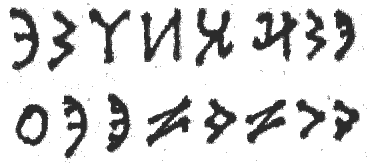
Table 7.2.5-3: Transcription of the Two-row Inscription of Khumara
| Written with normalized Khazar Rovas font (RTL) |
 |
|
Common Turkic (Khazar) (RTL
transcription) |
namsa ,ɣuzumunï
ja ebine nüththø |
| IPA phonetic transcription (LTR transliteration) |
 |
| Translation from Common Turkic (Khazar) |
‘Our nest [=home], As(es), call it mansion of Ödün.' |
The inscription in Fig. 7.2.5-3 equals to the second and third rows of the inscription of the
Table 7.2.5-2. However, there are dialectical differences between the Table 7.2.5-2 and
3. For instance, in the first row in Table 7.2.5-3  CENTRAL
Z /z/ was used instead of CENTRAL
Z /z/ was used instead of  SHARP
D /ð/ in Table 7.2.5-2. A similar dialectical difference is between /ïn/ in Table 7.2.5-3 and /ðïn/ in
Table 7.2.5-2. SHARP
D /ð/ in Table 7.2.5-2. A similar dialectical difference is between /ïn/ in Table 7.2.5-3 and /ðïn/ in
Table 7.2.5-2.
503 Kuznetsov 1963, Fig. 3-1; TürkicWorld, web site
504 Ligeti 1958. p. 448; Ligeti 1977, p. 78, Kononov 1980, p. 96
505 Vekony 2004b
157
The ligature
 was composed of was composed of  ARCHED I /ï/ and ARCHED I /ï/ and  N /n/,
the auxiliary slanted line was presumably applied in order to differentiate it from ) N /n/,
the auxiliary slanted line was presumably applied in order to differentiate it from )  ARCHED
E /a/. The /n/ in the word Ödün was probably a diminutive suffix.
(There is something alarming about similarity of the name Ödün of the Caucasus Ases and
the name Odin of the Scandinavian Ases, both of the princely variety) ARCHED
E /a/. The /n/ in the word Ödün was probably a diminutive suffix.
(There is something alarming about similarity of the name Ödün of the Caucasus Ases and
the name Odin of the Scandinavian Ases, both of the princely variety)
The inscription in Fig. 7.2.5-4 is fragmentary; its transcription needed a reconstruction (drawing of the archaeologist G. Vekony based on A.M. Shcherbak’s
publication).506
Figure 7.2.5-4. Drawing of a fragmentary inscription from Khumara Fortress.507
On this relic, the glyph
 - a mirrored variant of the
N GH /ɣ/ was used. - a mirrored variant of the
N GH /ɣ/ was used.

Table 7.2.5-4: Transcription of the One-row Ogur Inscription of Khumara
| Written with normalized Khazar Rovas font (RTL) |
 |
|
Common Turkic (Khazar) (RTL
transcription) |
rï igishib, idpaʒ, salaɣut |
| IPA phonetic transcription (LTR transliteration) |
 |
| Translation from Ogur |
‘Tughalas made (built?), wrote its inscription.’
or:
‘N. Tughalas made (built?), wrote its inscription.’ |
The word /tuɣalas/ is an ethnic name according to Ibn Rustah.508 The last word
/ïr/ is the Ogur version of the Common Turkic verb /yaz/ ‘draw’.509 The evidence of the existence of the Ogur verb
/ïr/ is the Hungarian verb ir /i:r/ ‘write’.510
The verb /ʒapdi/ (< Proto-Turkic /yap/) means ‘built, did’, the KR  SHARP
D is transcribed with /ʒ/, supposing (suggesting) that the inscription is in Ogur. The word /bitʃig/ is the Ogur version of the Common Turkic /bitig/.511 Since the
Tughalas /tuɣalas/ can be an ethnic name, it could also be a personal name. Moreover, since the beginning of the inscription is broken, the “<Personal name>, the Tughalas” structure is also a possible interpretation. An uncertainty of the transcription is the ligature SHARP
D is transcribed with /ʒ/, supposing (suggesting) that the inscription is in Ogur. The word /bitʃig/ is the Ogur version of the Common Turkic /bitig/.511 Since the
Tughalas /tuɣalas/ can be an ethnic name, it could also be a personal name. Moreover, since the beginning of the inscription is broken, the “<Personal name>, the Tughalas” structure is also a possible interpretation. An uncertainty of the transcription is the ligature
 /di/ in the reconstruction of the word /di/ in the reconstruction of the word
  >
/dʒapdi/ ‘made’, since the lower part of the ligature is damaged. >
/dʒapdi/ ‘made’, since the lower part of the ligature is damaged.
The described specifics of the Ogur vs. Oguz (aka Common Turkic) variety suggests
that the Oguz form with a prosthetic semi-consonant is an Ogur form /yaz/, adopted into Oguz
languages with the anlaut semi-consonant and preserved there, while the form /ïr/ in the
inscription reflects the loss of the initial semi-consonant typical for the Oguz languages. With the
north/south divide between the Oguz and Ogur, that would indicate that the Türkic term “write”
originated in the south-west. The verb /ʒap-/ would be a conforming Ogur form with anlaut
prosthetic consonant for the Oguz counterpart with anlaut semi-consonant /yap/ that has nothing to
do with the mythical “Proto-Turkic”
language. The /t/ <=> /tʃ/ is a non-specific dialectal alteration, it arises under an influence of
palatalized speech, like Chuvash and Slavic.
The ethnonym Taulas is still active, Taulases occupy the summit area at the
Daryal Pass on its southern side. The tau/tag/taɣ/tug stands for “mountain”,
-l- is an adjectival suffix a la “mountainous”, and -as is the ethnonym “As”, i.e. “Mountain
As”; the reconstructed t(a)uɣ[a]l + as does not need the suggested bracketed
[a], i.e
Tauglas. That a Taulas was noted in inscription is natural for a migrant, everybody else on the
construction crew was not from the Taulases. The modern Taulases can't be confused with the
historical Taulases. The modern Taulases are predominantly descendents of the local Adyge
population, of G2 Y-DNA variety (G2a1a1), that migrated from the Old Europe 4000 ybp, their
Adyge-type language is now the Ossetian language. The small admixture of R1a and R1b haplogroups are
the relicts of the historical As population that gave its name to the modern Taulases.
|
7.2.6. Novocherkassk Clay Flask Inscription in Kypchak
A clay flask with two handles was found during the construction of Salsk-Tsaritsyn (currently Volgograd) railroad in 1909.512 There are similar flask finds from around Novocherkassk with typical dimensions: width is no larger than 8 cm; diameter is about 30-35 cm. According to Artamonov, the origin of the clay flask on the
Fig. 7.2.6-1 is the 9th - 10th centuries. Under the right handle, on the convex side of the flask, there is a KR inscription.
Fig. 7.2.6-1 shows its photograph, and Fig. 7.2.6-2 presents its drawing.
506 Shcherbak 1962, Fig. 1
507 Vekony 2004b
508 DeGoeje, M. J. fed.) 1892
509 Vâsâry 2010-2011
510 Pallö 1982. p. 111-113
511 Röna-Tas 1992, pp. 12-13
512 Artamonov 1954, p. 264
158 Figure 7.2.6-1: The Novocherkassk Inscription (9th-10th centuries)513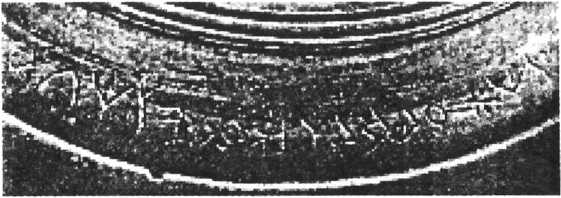
Figure 7.2.6-1: The drawing of the Novocherkassk Inscription.514
On this relic, the glyph
 - a variant of the
- a variant of the FORKED
O /o/u/ was used. FORKED
O /o/u/ was used.

Table 7.2.6-1: Transcription of the Novocherkassk Inscription.
The transcription of the archaeologist-historian G. Vekony 515 was modified by Turkologist I. Vâsâry in 2011. 516
| Written with normalized Khazar Rovas font (RTL) |
 |
|
Common Turkic (Kypchak) (RTL
transcription) |
nidashob thimreshi thib thimreshi a |
| IPA phonetic transcription (LTR transliteration) |
 |
| Translation from Common Turkic (Kypchak) |
‘Oh. Let us drink. We drink from [this] bosha.’ |
The word bosha was the name of a fermented alcoholic drink; Sec. 6.2.9 presents the genealogy of the word. In this case, the OPEN
V probably represented /b-/, since the inscription was written in Common Turkic, where in the beginning of the word /b-/ was pronounced instead of /β-/.517 The word /-dïn/ is a Turkic ablative suffix, meaning ‘from’. OPEN
V probably represented /b-/, since the inscription was written in Common Turkic, where in the beginning of the word /b-/ was pronounced instead of /β-/.517 The word /-dïn/ is a Turkic ablative suffix, meaning ‘from’.
7.2.7. Village Krivyanskoe Clay Flask Inscription in Preossetic (As-Alan)
In May 1942, a clay flask was discovered, at a depth of 1.5 meters, near Village Krivyanskoe (Fig. 7.2.7-1).518 Its inscription was published by Artanomov in 1954, with the original punctuation by Turchaninov in 1964 and in 1971.519 Figure
7.2.7-2 shows Turchaninov’s drawing.
513 Baichorov 1989, Table 113
514 Vekony 2004a, p. 243
515 Vekony 2004a, pp. 243-252
516 Vâsâry 2010-2011
517 Vâsâry 2010-2011
518 Artamonov 1954, p. 263-268
519 Turchaninov 1964 & 1971
159 Figure 7.2.7-1: The photographs of the
Village Krivyanskoe Inscription (9th—10th centuries)520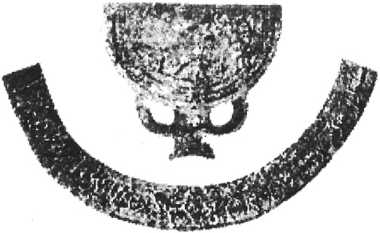
Figure 7.2.7-2: The drawing of the Village Krivyanskoe Inscription.521
On this relic, the glyph
 -a variant of the
-a variant of the FORKED O /o/u/ was used. FORKED O /o/u/ was used.

Table 7.2.7-1: Transcription of the Village Krivyanskoe Inscription
| Written with normalized KR font |
 |
|
Common Turkic (Kypchak?) (RTL
transcription) |
a-atsifab gechau nachixath gazuin thirach unad ubath unadushov |
| IPA phonetic transcription (LTR transliteration) |
 |
| Translation from As-Alan (Preossetic) |
‘[This] voshu drink is yours. [This] drink should keep alive [the] one who drinks [it]. For you, Uachag wrote this.’ |
In this relic, the form voshu of the drink boza (English
booze) occurs;522
Sec. 6.2.9 presented the genealogy of this word. The sound /a/ was a Preossetic common
determiner, meaning ‘this’. This /a/ is written in the duplication of FORKED
E /a/ ( FORKED
E /a/ ( /a-a/ at the end of the row, where the other /a/ is the last vowel of the word /bafista/. In the inscription at the end of the word /niuzag/, there is the diacritic mark o COMBINING DOT ABOVE, a specific
Khazar Rovas word separator. The use of this separator in the inscription was probably occasionally mixed with the other
Khazar Rovas separator, the /a-a/ at the end of the row, where the other /a/ is the last vowel of the word /bafista/. In the inscription at the end of the word /niuzag/, there is the diacritic mark o COMBINING DOT ABOVE, a specific
Khazar Rovas word separator. The use of this separator in the inscription was probably occasionally mixed with the other
Khazar Rovas separator, the
 TRICOLON. TRICOLON.
What is “Preossetic” one God knows. Probably it is a reverse projection of a
blend of the modern Ossetic languages, then it is a mixture of the Adyge (Y-DNA G2a1a1) and Near
Eastern (Y-DNA J2) substrate of the Ossetic, impregnated with few Turkisms accumulated for the past
1700 years. If it is an allusion to the Türkic language of Ases or Alans, or the much later
Kipchaks, the enigma just grows bigger. The very term used, “Preossetic”, attests that the language
has nothing to do with the Khazars and their multi-variegated Türkic ilk, including the Ases or
Alans.
|
7.2.8. Spindle Disk of Minusinsk
In 1948, a rounded stone of a spindle was explored during the archaeological excavations of V.P. Levasova near Minusinsk. The relic is from the 8th
- 9th centuries, currently preserved in the Minusinsk Museum.523 There are Old Turkic symbols on the flat surfaces of the spindle disk, and there is a
Khazar Rovas inscription on its arched lateral surface. Fig. 7.2.8-1 presents the photograph of the spindle disk,524 and
Fig. 7.2.8-2 shows the drawing and the transcription made by Vekony.525 The transcription was improved by Vâsâry.526
520 Baichorov 1989, Table 116
521 Turchaninov 1964, pp. 83 -84 & 1971, pp. 75-77
522 Vekony 2004a, p. 257
523 Vasilev 1983, p. 40, No. E-87
524 TÜRIK BITIG, web site
525 Vekony 2004b
526 Vâsâry 2010-2011
160
Figure 7.2.8-1: The photograph of the spindle disk of Minusinsk 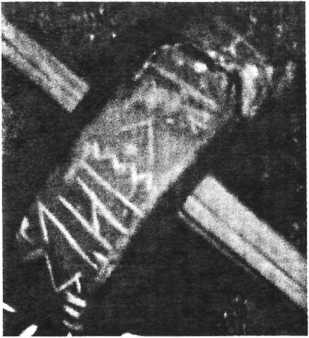
Figure 7.2.8-2: The copy of the inscription broken into two rows
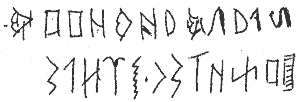
On this relic, the glyph variant
 of the
of the CIRCLE
ENDED I /i/ï/, CIRCLE
ENDED I /i/ï/,
 of the of the SHARP UE /y/, SHARP UE /y/,
 of the
of the CENTRAL
Z /z/t/, and the mirrored glyph CENTRAL
Z /z/t/, and the mirrored glyph
 of the
N GH /ɣ/ were used. The glyph
of the
N GH /ɣ/ were used. The glyph
 - a variant of the symbol - a variant of the symbol
 KHAZAR ROVAS SEPARATOR LARGE was also used on this relic.
KHAZAR ROVAS SEPARATOR LARGE was also used on this relic.
Table 7.2.8-1: Transcription of the Inscription of Minusinsk.
| Written with normalized Khazar Rovas font (RTL) |
 |
|
Common Turkic (Kypchak) (RTL
transcription) |
gyrrygyj gij-pi
mapaɣus(a) themlytrø (ürtülmiş(le:rke:) Clauson p. 209) |
| IPA phonetic transcription (LTR transliteration) |
 |
| Translation from Turkic |
‘(This) thread-spindle [is] fast. My aunt (A)sugh does not hide.’ |
An interesting specialty of this relic is that the fifth character from the right and the last (leftmost) character of the first row in
Fig. 7.2.8-2 are corrected: the writer earlier wrote  TRIPLE GH /ɣ/ in both cases, and then corrected them with TRIPLE GH /ɣ/ in both cases, and then corrected them with CLOSE G
/g/. In other words, the writer first used the fricative /ɣ/, and then it was corrected to the plosive
/g/. The personal name in the inscription can be either Asugh /asuɣ/ or Sugh /suɣ/.
(örtül-/ürtül- is passive of “conceal, cover, hide” > “hidden by
my Asug-apa”) CLOSE G
/g/. In other words, the writer first used the fricative /ɣ/, and then it was corrected to the plosive
/g/. The personal name in the inscription can be either Asugh /asuɣ/ or Sugh /suɣ/.
(örtül-/ürtül- is passive of “conceal, cover, hide” > “hidden by
my Asug-apa”)
161
7.2.9. Mayak Fortress Large Building Inscription
In 1978, during the Soviet-Hungarian-Bulgarian common excavations of the Mayak Fortress (‘Stone Castle of
Mayak’, other name: Mayaki citadel), S.A. Pletneva and G.E. Afanasyev found the longest known KR inscription.527 The citadel was built in the 9th century; the city itself existed from the end of the 8th century and it belonged to the territory of the As-Alans.528.
Fig. 7.2.9-1 a and b are drawings of the architect B. Erdelyi, a participant in the excavation.529
Figure 7.2.9-la, b: Drawings of the Inscription of Mayak Fortress by architect B. Erdelyi.
On
this relic, the glyph variants
 of the
of the FORKED
O /o/u/, FORKED
O /o/u/,
 of the of the DIAGONAL E /ɛ/, and DIAGONAL E /ɛ/, and
 of the of the  ARCHED UE /ø/y/ were used. ARCHED UE /ø/y/ were used.
| a) |
b) |
 |
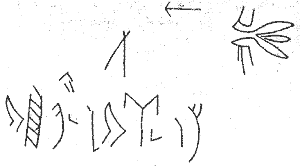 |
527 Erdelyi 2004a, p. 76
528 Erdelyi 1991
529 Kyzlasov 1990; p. 16
162
Figure 7.2.9-2: The drawing of the Inscription of Mayak Fortress reconstructed by archaeologist G. Vekony

The ends of the first and second rows may show characters of a different script; those were probably engraved later.
Table 7.2.9-1 presents the transcription of the inscription.530
Table 7.2.9-1: Transcription of the Large Building Inscription of Mayak Fortress
| Written with normalized Khazar Rovas font (RTL) |
 |
|
Common Turkic (Khazar) (RTL
transcription) |
First row: [...] ngïrïβas itla thibired ngithib naɣax
mishe lisa bus gythö qa unad
Second row: [...] geniuthad lo idethideb gisi shygy etli adnum no ythid thu
Third row: ög ibe niget ɣano |
| IPA phonetic transcription (LTR transliteration) |
 |
| Translation from Common Turkic (Khazar) |
First row: 'Don [River], white Ödüg River, As Country, [oh] my brother-khagan, our land of the Six-Savirs ...’
Second row: ‘Ud Didü On, here, in [this] country, ornamented several works. This inscription made by Ineg...’
‘Mansion of Onagh Tegin. Extol it.’ |
First row: Danu is the Don River in the As-Alan language. The Aq means white; this is probably the attribute of the following river-name
Ödüg or the name of another river. Ödüg is the Khazar name of the Dnieper River.531 The /alti
saβïr/ ‘Six-Savirs’ is the name of a nation, as in the Turkic languages, the ethnic name made of the structure of number+name is typical, e.g., Onogur ‘Ten-Ogurs’. According to the historian al-Mascüdi (10th century), the Turks called the Khazars Savirs.532 Based on this data, in this Rovas inscription, the alternative name of the Khazars was ‘Six-Savirs’. According to the author of this book, the original ethnic name could have been the Six-Savirs if the ethnic name Khazar originated from the Roman title Caesar as Röna-Tas stated (Sect. 3.5.1).533 In the last word (from the right), the character between R /r/ and R /r/ and NG
/ŋ/ is hard to read; Vekony reconstructed it as NG
/ŋ/ is hard to read; Vekony reconstructed it as ARCHED I /ï/. ARCHED I /ï/.
The parsing of the inscription is heavy on nouns and light on morphology, resembling other
unsuccessful reconstructions with spurious flavor. Typical Türkic phrase is heavy on conjugations
and declensions, and light on nominals and verbs. In addition to being reasonable phonetically, a
phrase must also make sense.
In Türkic don is “cold, icy”, Herodotus said: “icy Tanais”, hence here the inscription
says in Savir language “icy, white”. Nobody knows what was the As-Alan name for Don, the inherited
from the locals default
As-Alan name is also the Türkic Don “cold, icy”. The conflation of the names As, a part
of the known As-Tokhar confederation, and the umbrella term Alan “Steppe-man, Flatlander” is
disturbing. Tokhars, for example, were Alans, but not the Ases.
From Herodotus times to the end of the 10th c. AD the local name for
Dnieper, and also for Buh, was a range of allophones, reflexes, and calques: from Βορυσθένης (Borusthenes),
Borysthenes to Burichai, meaning “Bear stream”. The Buh was discriminated by adjective “White”: Κουβοΰ “White
Winding”, where Kuu is “White”. Khazars were not natives of the Dnieper basin, it is inconceivable that they
would come up with new names for old places of common knowledge. Ödüg in the inscription may be “selected,
chosen” river, i.e. a fort on the suitable river, cf. ödür- “select, choose”. That
is, if the parsing is accurate.
The Arabs called Savirs, and numerous other
ethnically non-Khazar people, Khazars. Savirs (Suvars) are known in the Caucasus much earlier
than the Khazars, and they were a ruling tribe before the advent of the Khazars. The Arabs, like the
Khazars, were late comers, the Arab term Khazar is solely political and separate from the
ethnic terms. The term Savir is ethnic and political; in addition to being specifically
ethnic, it also covered numerous ethnicities in the Savir domain: Kayis, Masguts/Massagets/Alans,
Huns, Bulgars, etc., and all local sedentary tribes.
The Six-Savirs confederation has no relation to the Khazars other
than it has transferred to the Khazar Kaganate their suzerain authority after their capital Samandar
was taken by the Arab commander Maslama in course of 727/728 campaign.
Whatever speculations on the origin of the name Khazar are, the names Khazar and Six-Savirs
are not related other than by political correlation.
|
Second row: Ud Didü On /uð diðy °n/ was a personal name. Another possible transcription of    /diðy/ is /didy/. This was one of the Khazar versions of the ethnic name Jewish. Its other version was found in the Alsöszentmihâlyfalva Inscription (Fig. 7.2.14-2). Both words originated from Hebrew.534 /diðy/ is /didy/. This was one of the Khazar versions of the ethnic name Jewish. Its other version was found in the Alsöszentmihâlyfalva Inscription (Fig. 7.2.14-2). Both words originated from Hebrew.534
Here we have another disconnect: Suvars would unlikely use a Hebrew word for Jews
when they have a Caucasian lingua franca word Djuga (cf. Djugashvilli “Son of Jew”) , known and
understood by everybody in the Caucasus. The ud or uth is “cow”, on is “ten”,
as a noun phrase the compound is unrealistic “Ten-cow Jew” or some perturbation of these three words
as a name for a Jewish chief artisan in charge of decoration of the fortress. He also had a title,
in a third-person reference naming a title is expected, naming a personal name is out of place.
|
530 Vekony 2004b
531 Golden 1979. p. 173; Golden 1980. p. 252
532 DeGoeje 1893 1894, p. 120
533 Röna-Tas 1999a, p. 228
163
Third row: The second character from the right needs reconstruction: it was
N GH /ɣ/ or FORKED
E /a/, and therefore, the first word was Onagh N FORKED
E /a/, and therefore, the first word was Onagh N /onaɣ/ or
Ona Y /onaɣ/ or
Ona Y /ona/. /ona/.
The inscription contains much information: the writer was Ineg, the builder was Ud Didü On, the nation was Six-Savirs, and the fortress was the Mansion of Onagh Tegin. The inscription declared the Khazars’ supremacy of the region between the Don and Dnieper rivers, the land of the As people. It is noteworthy that the Mayaki Fortress was near the Don River; this geographical fact supports the exactness of the transcription.
7.2.10. Mayak Fortress smaller inscriptions
In 1909, N. E. Makarenko found short Rovas inscriptions in the Mayaki Fortress. They are dated to the period from the late 8th to the 9th centuries.535 The drawings of the
Khazar Rovas inscriptions were published by G.F. Turchaninov as well (Fig. 7.2.10-1,2,3,4,56).536 In the followings, the transcriptions are presented after each drawing.537
Figure 7.2.10-1: Drawing of the Khazar Rovas Inscription No. 1 of Mayak Fortress538

Table 7.2.10-1: Transcription of the Inscription No. I of Mayak Fortress
| Written with normalized Khazar Rovas font (RTL) |
 |
|
Common Turkic (Khazar) (RTL
transcription) |
...β nibjaqðad or ...k
nibjaqðad |
| IPA phonetic transcription (LTR transliteration) |
 |
| Translation from Common Turkic (Khazar) |
‘I will write w ...’ or ‘I will write k ...’ |
The left hand character can be OPEN V /(β/b-/ or OPEN V /(β/b-/ or FORKED K /k/ as well. This inscription shows typical features of the Khazar language: in the beginning of the word the changes /j/ > /d/ and
/z/ > /ð/ happened. However, the change /j/ > /d/ did not appear in every Khazar dialect; as it can be compared in the two versions of the name ‘Jewish’: /diðy/ in the
Mayak
Fortress Relic (Table 7.2.9-1) and /jyedi/ in the Alsöszentmihâlyfalva Relic (Table 7.2.14-1).
(Yedi, like Djuga, stands for Iudea. It is a common designation in Common
Türkic outside of the Caucasus) FORKED K /k/ as well. This inscription shows typical features of the Khazar language: in the beginning of the word the changes /j/ > /d/ and
/z/ > /ð/ happened. However, the change /j/ > /d/ did not appear in every Khazar dialect; as it can be compared in the two versions of the name ‘Jewish’: /diðy/ in the
Mayak
Fortress Relic (Table 7.2.9-1) and /jyedi/ in the Alsöszentmihâlyfalva Relic (Table 7.2.14-1).
(Yedi, like Djuga, stands for Iudea. It is a common designation in Common
Türkic outside of the Caucasus)
534 Vekony 2004a, pp. 221-222
535 Makarenko 1911, pp. 21-22, Fig. 19-22
536 Turchaninov 1964, pp. 75-76
537 Vekony 2004b
538 Vekony 2004b
539 Vekony 2004b
164
Figure 7.2.10-2: Drawing of the Khazar Rovas Inscription No. 2 of Mayak Fortress539

Table 7.2. JO-2: Transcription of the Inscription No. 2 of Mayak Fortress
| Written with normalized Khazar Rovas font (RTL) |
 |
|
Common Turkic (Ogur) (RTL
transcription) |
mirtesitheb |
| IPA phonetic transcription (LTR transliteration) |
 |
| Translation from Ogur |
‘N. [member of a clan], I had it carved.’ |
The first two symbols of the inscription make up a tamga. Similarly, complex tamga symbols are known in other Rovas inscriptions, e.g. Needle Case of Jânoshida (Sec. 6.2.3).540 The glyph of the KR ARCHED I
/i/ is reversed in the inscription; however, mirroring glyphs is usual in KR. ARCHED I
/i/ is reversed in the inscription; however, mirroring glyphs is usual in KR.
There is a Common Turkic verb /beðiz/ meaning ‘carve’. The Ogur does not have the consonant /z/; hence it substituted
/z/ with /s/. Therefore, the inscription is in Ogur language and the word /beðiz/ was a Common Turkic loanword. The word /beðizet/ is a causative form; its meaning: to have it carved. The /beðizetrim/ means ‘I had it carved’. Since the
tamga means a clan-name, the meaning of the inscription is ‘N. [member of a clan], I had it carved’.
Tamga is a community property, and does not change as long as the clan exists, and long after
its dispersion. Tamga
 must be known from the Caucasus tamga catalogs, or else it is not an attested tamga, and could be a
part of the inscription.
must be known from the Caucasus tamga catalogs, or else it is not an attested tamga, and could be a
part of the inscription. |
Figure 7.2.10-3: Drawing of the Khazar Rovas Inscription No. 3 of Mayak Fortress541
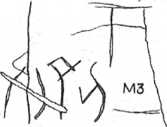
Table 7.2.10-3: Transcription of the Inscription No. 3 of Mayak Fortress
| Written with normalized Khazar Rovas font (RTL) |
 |
|
Common Turkic (As-Alan) (RTL
transcription) |
dnabin |
| IPA phonetic transcription (LTR transliteration) |
/niband/ |
| Translation from As-Alan |
‘Bonding’ |
The character
 is the ligature of is the ligature of RAISED B /b/, Y A /a/ and RAISED B /b/, Y A /a/ and N
/n/. A special feature of this relic is that the inscription is on two stones, in a way that the half of the character N
/n/. A special feature of this relic is that the inscription is on two stones, in a way that the half of the character ARCHED D
/d/ is on one stone and its other half is on another stone fitting the first one. The purpose of the text is obvious: it is a
building order showing where the bonding has to be made. ARCHED D
/d/ is on one stone and its other half is on another stone fitting the first one. The purpose of the text is obvious: it is a
building order showing where the bonding has to be made.
Figure 7.2.10-4: Drawing of the Rovas Inscription No. 4 of Mayak Fortress542

The character
 is the ligature of D CLOSE J /j/ and the mirrored glyph of is the ligature of D CLOSE J /j/ and the mirrored glyph of ANGLED I /i/. In this inscription, the glyph ANGLED I /i/. In this inscription, the glyph
 , a mirrored variant of the , a mirrored variant of the OPEN M /m/ was in use. This relic is related to the text of the
Table 7.2.10-3. OPEN M /m/ was in use. This relic is related to the text of the
Table 7.2.10-3.
540 Vasary 1972, Fig. 1
541 Makarenko, 1911, p. 28, Fig. M3
542 Vekony 2004b
165
Table 7.2.10-4: Transcription of the Inscription No. 4 of Mayak Fortress
| Written with normalized Khazar Rovas font (RTL) |
 |
|
Common Turkic (Kypchak) (RTL
transcription) |
makijamas |
| IPA phonetic transcription (LTR transliteration) |
/samajikam/ |
| Translation from As or Alan |
‘Let us assemble it.’ |
Figure 7.2.10-5a: The photograph of the Khazar Rovas Inscription No. 5 of Mayak Fortress made by
S. Ya. Baichorov, and b) its drawing543
| a) |
b) |
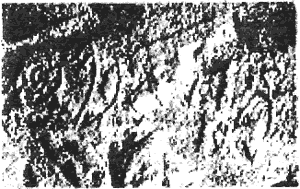 |
 |
In this inscription, the glyph
 a mirrored variant of the a mirrored variant of the ARCHED
I /i/ï/ was used. ARCHED
I /i/ï/ was used.
Table 7.2.10-5: Transcription of the Inscription No. 5 of Mayak Fortress
The /-aq/ is a Turkic diminutive suffix of the personal name /on/, it means ‘ten’.544
| Written with normalized Khazar Rovas font (RTL) |
 |
|
Common Turkic (Khazar) (RTL
transcription) |
ibe qano |
| IPA phonetic transcription (LTR transliteration) |
/onaq ɛbi/ |
| Translation from Common Turkic (Khazar) |
‘Mansion of Onaq’ |
7.2.11. Bilingual Khazar Coin of Sweden
An inscribed coin was found in Sweden with Arabic and Khazar Runiform characters (Fig.
7.2.11-la, b, and c)545
Figure 7.2.11-1 a, b)
The Arabic and c) Khazar Runiform inscriptions on the Bilingual Khazar Coin of Sweden
| a) |
b) |
c) |
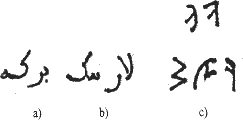 |
The Arabic inscription in Fig. 1.2.11-la means blessing or wealth,546
and in Fig. 7.2.11-lb a personal name: /nâr yık/. The transcription of the Khazar inscription
of Fig. 7.2.11-1c is presented in Table 7.2.11-1.
543 Baichorov 1989, Table 120
544 Gombocz 1915, pp. 38-39
545 Vekony 1997a
546 Charaf 2010
166 aishermith bith ishermith boshadin
Table 7.2.11-1: Transcription of the Khazar Runiform inscriptions on the Bilingual Khazar Coin of Sweden
| Written with normalized Khazar Rovas font (RTL) |
First row:
 ; second row: ; second row:
 |
|
Common Turkic (Kypchak) (RTL
transcription) |
First row: ybø; second row:
mith ik |
| IPA phonetic transcription (LTR transliteration) |
First row: /øβy/; second row: /ik øðim/ |
| Translation from Common Turkic (Khazar) |
First row: 'Extolling’; second row: 'Ik, myself’ |
The word /ik/ was a personal pronoun. Vekony claimed that this word is in Common Turkic (surely
Khazar); since its Ogur version would be /yik/.547 However,
Gombocz stated that the /yik/ in the Arabic text corresponded to the Common Turkic (Khazar) /ik/.548
The runic Khazar
 /ik/ Ik “I” is an allophone of the German Ich, Ih “I”, and English I
“I”. The other Germanic, Celtic, Latin, Greek forms are all allophones of the Khazar Ik:
Anglo-Saxon ik (spelled ic), Dan., Norse jeg, Dan. ik, Icl. eg;
Ir. agam, me ag “I mine, me I”, Welsh wyf, Lat. ego, Gk ego (εγώ), ekho (έχω),
all “I”. The Irish form is peculiar, it literally combines semantics of “inner” with the semantics
of “me”. The form ič of the Türkic word “inner” is the base for the Türkic ič “I” and
all its known allophones across Eurasia. The me (min, men, bin, ben) is the objective form of
“I”, and probably it was in circulation long before the form ič has appeared. The Irish has
preserved frozen archaic forms from the time when without definition “me”, “mine”, the ič “I”
still denoted “inner”
/ik/ Ik “I” is an allophone of the German Ich, Ih “I”, and English I
“I”. The other Germanic, Celtic, Latin, Greek forms are all allophones of the Khazar Ik:
Anglo-Saxon ik (spelled ic), Dan., Norse jeg, Dan. ik, Icl. eg;
Ir. agam, me ag “I mine, me I”, Welsh wyf, Lat. ego, Gk ego (εγώ), ekho (έχω),
all “I”. The Irish form is peculiar, it literally combines semantics of “inner” with the semantics
of “me”. The form ič of the Türkic word “inner” is the base for the Türkic ič “I” and
all its known allophones across Eurasia. The me (min, men, bin, ben) is the objective form of
“I”, and probably it was in circulation long before the form ič has appeared. The Irish has
preserved frozen archaic forms from the time when without definition “me”, “mine”, the ič “I”
still denoted “inner” |
The /nar/ was the name of a Kagan; see Kagan Nar
 /nar xaɣan/ the Ogur inscription of the Mayaki Amphora (Fig.
7.2.2-2). The Arabic inscription of the coin contains the full name of the Kagan: Nar Ik in
Common Turkic (Khazar). (I.e. “I (myself) Nar”) To summarize, the Arabic and the Khazar Runiform inscriptions on the coin
are essentially identical.
/nar xaɣan/ the Ogur inscription of the Mayaki Amphora (Fig.
7.2.2-2). The Arabic inscription of the coin contains the full name of the Kagan: Nar Ik in
Common Turkic (Khazar). (I.e. “I (myself) Nar”) To summarize, the Arabic and the Khazar Runiform inscriptions on the coin
are essentially identical.
7.2.12. Cattle skull from the kurgan Ermen TolgaIn 1970, a fragmented cattle skull was found in the plundered central burial of the kurgan Ermen Tolga, 15 km from Elista (Capital of Kalmykia, Russia).549 In the scientific literature, it is several times called bull skull. The relic is from the period between the 8th and 10th centuries. There are inscriptions on 11 of the 16 fragments of the skull. According to S.G. Klyashtorny and I. Vâsâry, there are 80 symbols on the fragments.550 Fig.
7.2.12-1 presents the third row of the three-row inscription; Fig.7.2.12-2 shows the drawing of the reconstructed cattle skull; and in
Fig. 7.2.12-3 there is the drawing of the reconstructed skull with the inscriptions. The cattle skull was reconstructed by the archaeologist I. Erdelyi and the archaeozoologist I. Takâcs.551 According to Takâcs, the age of the cattle was adultis/maturus.552 According to Erdelyi, the inscription was written by two persons sitting opposite to each other, since the style of two rows of the inscription significantly differs from the third row being upside down.553
Table 7.2.12-1 presents the transcription of the texts.554
Figure 7.2.12-1: The fragments of the cattle skull of Ermen Tolga.555
On this relic, the glyph
 - a mirrored variant of the - a mirrored variant of the OPEN
M /m/ and the glyph OPEN
M /m/ and the glyph
 - a variant of the
- a variant of the ARCHED UE
/ø/y/ were used. ARCHED UE
/ø/y/ were used.
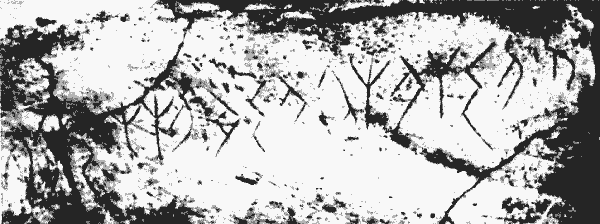
547 Vekony 2004a, p. 282
548 Gombocz 1915, p. 48; Gombocz 1908, p. 22; Gombocz 1912
549 Erdniev 1982, Fig. 2-7; Kyzlasov 1990a, Fig. 13. 14. pp. 42-47
550 Klyashtomy & Vâsâry 1987
551 Erdelyi 1991, pp. 150-153
552 Erdelyi 1991, p. 150
553 Erdelyi 2010
554 Vekony 2004b
167
| Figure 7.2.12-2: Reconstruction of the cattle skull of Ermen Tolga |
Figure 7.2.12-3: The drawing of the fragmented Inscription of Ermen Tolga |
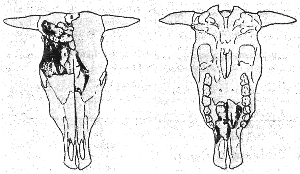 |
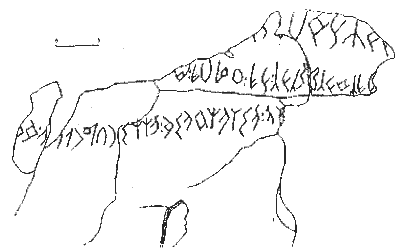 |
Table 7.2.12-1: Transcription of the fragmented Inscription of Ermen Tolga
| Written with normalized KR font |
 |
|
Common Turkic (Khazar) (RTL
transcription) |
Second row (upside down): ...ö aba-be egy maba ö bed idi deb
First row (upside down): ...[a]ba ishyb du
Third row:
... ö ... thide aŋam : shi ishyb maba ed shab emö : ö a... / |
| IPA phonetic transcription (LTR transliteration) |
 |
| Translation from Common Turkic (Khazar) |
Second row: ‘Lord spirit, spirit, think! My father, wise house-father, think!’
First row: ’ . bovine-wizard father ...’
Third row: ’ Oh : think! Don’t think, Head! Eat! My wizard father, drink! For my highly ... think ...’ |
555 Vekony 1997a, cover inside
168
The word
 /deβ/ ‘spirit’ was an As or Alan loanword in the Khazar language (< Old Persian /daiva/). The expression /ɛb-aba/ ‘house-father’
(or “mother”, or generic “anscestor”) meant the spirit of the house, its defender. The inscription recorded a magic text, being probably rhythmically chanted during a shaman ritual.556 /deβ/ ‘spirit’ was an As or Alan loanword in the Khazar language (< Old Persian /daiva/). The expression /ɛb-aba/ ‘house-father’
(or “mother”, or generic “anscestor”) meant the spirit of the house, its defender. The inscription recorded a magic text, being probably rhythmically chanted during a shaman ritual.556
| With the polysemantics innate to the Türkic lexus, even a correct reading has a spectrum of
interpretations. To add to the unknown some unverifiable parsing, unattested borrowings, and
primitive religious biases really hurts the credence of the interpretation. Kurgans are the tools
supplied to a deceased relative to reach the Almighty Tengri for reincarnation, the kams (“shamans”
in Vekony's lingo) with their black magic are not admitted to the Tengrian rituals. There is no more
sacred ritual than the send-off to the Almighty, and a wealth of dedicatory grave inscriptions give
examples of what can be expected at a kurgan grave. The Ermen Tolga grave is located in the
territory of the Khazar domain, in the land of Saklans, which is connected with the “As or Alan”
only in the mythopoeic thought of some creative patriotic scientists. The very idea that Khazars had
an Old Persian loanword borrowed from the “As or Alan” language attests to the surreal mythopoeic
mentality underlying interpretations. |
7.2.13. Quiver Inscription of Homokmegy-Halom in Turkic
The Khazar Rovas inscription on a bone-plate covering a quiver was discovered by the archaeologist I. Dienes (Fig. 7.2.13-1), and was researched by Vasil’ev among others.557 The relic is from grave No. 6 of a cemetery dating to the period of the Magyars’ Landtaking (10th century).558 This cemetery is in Homokmegy-Halom (Hungary, see
Map 6.2-1), one of the centers of the Magyars led by the Grand Prince Ârpâd. According to I. Dienes, this type of quiver was unknown in the Avar Age; therefore, it surely was the product of the Magyars, and the owner of the quiver was a member of the Magyar Army.559
Fig. 7.2.13-2 presents the drawing of its inscription.560
| Figure 7.2.13-1: The bone-plate of the Quiver of Homokmegy-Halom (10lh century) |
| Positive image |
Negative image |
 |
 |
Figure 7.2.13-2: The drawing of the Inscription of Homokmegy-Halom561

The word
 /saɣdaɣ/ ’quiver’ is a loanword in Turkic; it originated from the Iranian /sa:xtag/ ‘garniture, equipment’. The transcription in
Table 7.2.13-1 was made by G. Vekony and it was improved by I. Vâsâry.562 According to the author, the KR /saɣdaɣ/ ’quiver’ is a loanword in Turkic; it originated from the Iranian /sa:xtag/ ‘garniture, equipment’. The transcription in
Table 7.2.13-1 was made by G. Vekony and it was improved by I. Vâsâry.562 According to the author, the KR  CLOSE G
/ɣ/ surely originated from the Inscriptional Pahlavi CLOSE G
/ɣ/ surely originated from the Inscriptional Pahlavi
 QOPH /q/. Presumably, the Iranian word /sa:xtag/ was accepted by Turkic with the /x/ > /q/ substitution in the middle of the word. That could be the reason why the KR QOPH /q/. Presumably, the Iranian word /sa:xtag/ was accepted by Turkic with the /x/ > /q/ substitution in the middle of the word. That could be the reason why the KR  CLOSE G originated from the
Inscriptional Pahlavi CLOSE G originated from the
Inscriptional Pahlavi
 QOPH /q/ was applied; and probably, the QOPH /q/ was applied; and probably, the  CLOSE G represented /q/ at that time. Later, the /q/ > /ɣ/ transition happened. Due to the conservativity of the writing, the CLOSE G represented /q/ at that time. Later, the /q/ > /ɣ/ transition happened. Due to the conservativity of the writing, the  CLOSE G remained in this word, but it already represented /ɣ/. CLOSE G remained in this word, but it already represented /ɣ/.
Table 7.2.13-1: Transcription of the Inscription of Homokmegy-Halom
| Written with normalized Khazar Rovas font (RTL) |
 |
|
Common Turkic (Bulgar?) (RTL
transcription) |
onogliɣ saɣdaɣin sab |
| IPA phonetic transcription (LTR transliteration) |
/onogliɣ saɣdaɣin bas
/ |
| Translation from Turkic |
‘Triumph with [a] quiver of ten arrows’ |
Ligeti L. Mots de civilisation de Haute Asie en transcription chinoise // Acta Orientalia.
1950. pp. 141-149, discussed the Hunnic word sagdag meaning boots, given in Chinese
transcription, and speculated on its origin. It turned out that that word was borrowed from the
Türkic, likely Kazan Tatars, into Russian, in the form sagaidak (ñàãàéäàê), and was widely
used in Russia in 16th-17th cc [L. N. Gumilev, 1960, History of Hunnu people, Moscow,
"Science", Ch.3]. Sagdag refers to the bootleg of the boots, where the mounted archers
kept their arrows in addition to the regular quiver, and the inscription refers to the ten arrows in
the bootleg of the boot. E. Pulleybank speculated that that word may be a Ket word, but that idea
was discarded based on the ethnological specifics of the hunter-gatherer practice. The Hunnic word
could have been borrowed into Old Persian from the Scythians and Kangars in the Persian service, but
at any case Bulgars had no need to borrow foreign lexicon for tools innate to their nomadic life.
The scholarly speculations are an exercise in fatuity, other than that the Old Persian and Türkic
scripts were adopted form the same source, albeit at different times, since the Persians switched
from the cuneiform to alphabetical writing relatively late.
According to Omniglot
http://www.omniglot.com/writing/mpersian.htm, Inscriptional Pahlavi did not have a character
q:
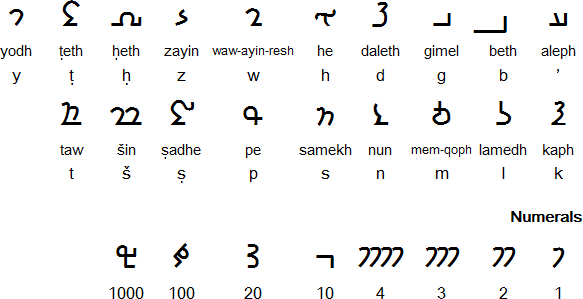
The polysemy of the word bas- is a good example of possible readings and misreadings. The
bas- is “to press”, “to stamp (with a stamp)”, “suppress, overcome”, “attack”, “take
over”. Probably, in this case the semantics of “suppress, overcome” was selected for “triumph”. The
possessive suffix -in points in a right direction: “My 10-arrow sagdag (would) prevail
(over enemy)”. |
556 Vekony 2004b
557 Vasil'ev 1983
558 Dienes 1972. p. 67; Dienes 1992, p. 31
559 Dienes 1992, p. 39
560 Dienes 1992. p. 31-40.
561 Vekony 1992a, p. 42
562 Vekony 2004a, pp. 56-47; Vâsâry 2010-2011
169
According to Vâsâry, the language of the inscription could be either Common Turkic or Ogur.563 This inscription proves that Turkic was used as well by the army of the Grand Prince Arpad. This supports the fact that the culture of the landtaking Magyars had a strong Turkic heritage. For instance, the mythological bird
turul of the Ârpâd Dynasty originated from the Turkic togril, which was a bird name.564 Another fact is that between 948 and 950, the Magyar leader Zombor visited Byzantium, and he returned with the missionary bishop Hierotheos, whose title was ‘Bishop of Turkia'.565
Each Türkic tribe had its ongon, a tribal bird, that distinguished the tribe from other
tribes. Ongon has a great diagnostic value, knowing the ongon can limit the number of candidates to
very small number.
|
7.2.14. Stone Inscription of Alsöszentmihâlyfalva in Khazar
The inscription on a building stone was found in Alsöszentmihâlyfalva (present-day Mihai Viteazul, Transylvania, Romania, see
Map 6.2-l)\ its photograph was made by E. Benkö (Fig. 7.2.14-1).566 The stone was an ancient Roman building stone - proved by the leaf-symbol, a frequently applied ornamental element of ancient Roman inscriptions - reused in the 10th century. Alsöszentmihâlyfalva was located on the territory where the late Province Dacia existed up to the middle of the 3rd century. Denes showed that the Khavars
(Kubars, Kuvars, Kovars, Cuvers) (Khazar rebels joined the Hungarians in the 9lh century567) probably settled in this region (at that time Transylvania).568 In some parts of Hungary, there is data of the Khavars even from the 13lh century.569 The drawing of the
Khazar Rovas inscription and its transcription are presented in Fig. 7.2.14-2 and Table 7.2.14-1.570
| Figure 7.2.14-1: The Alsöszentmihâlyfalva Inscription (920-952) |
| Positive image |
Negative image |
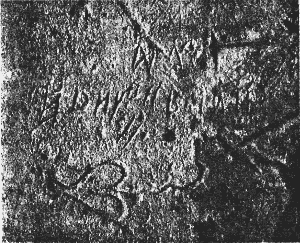 |
 |
563 Vâsâry 2010-2011
564 Vâsâry 2003
565 Tempfli 2000
566 Benkö, E„ 1972a, p. 453 & Appendix; 1972b
567 Kristö & Makk 2001, p. 52
568 Denes 1984-1985, p. 573
569 Györffy 1990, p. 50
570 Moravcsik 1984, p. 85; Vekony 1987a, pp. 108-117; 1997, pp. 108-117; 2004a, pp. 217-230
170
Figure 7.2.14-2: Drawing of the Alsöszentmihâlyfalva Inscription (920-952).
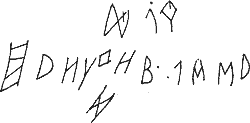
Table 7.2.14-1: Transcription of the Alsöszentmihâlyfalva Inscription
| Written with normalized Khazar Rovas font (RTL) |
 |
|
Common Turkic (Khazar) (RTL
transcription) |
First row: ɣilta ibe
Second row: jaraq ryk ideyj |
| IPA phonetic transcription (LTR transliteration) |
 |
| Translation from Common Turkic (Khazar) |
First row: ‘His mansion is famous’
Second row: ‘Jüedi Kür (the) Karaite’ |
The word /eb/ was used for larger buildings in the Khazar Rovas building inscriptions;571 therefore, its meaning is ‘mansion’. The building inscriptions are typical in KR relics (e.g.,
Sec. 7.2.9 and 10). The word /jyedj/ meant Jewish in the Khazar language, in this case it was probably used as a personal name. The /kyr/ means ‘courageous’ and ‘fearless’ in Turkic,572 such personal names are typical. Therefore, the second row or at least the first two words (Jüedi Kür) formed the name of a Khavar leader. Presumably, the word Karaite was also a personal name. The symbol
 is a typical punctuation mark in KR and the symbol in the third row was probably a
tamga, according to Vekony. is a typical punctuation mark in KR and the symbol in the third row was probably a
tamga, according to Vekony.
The Karaite Judaism is a branch of the Jewish religion accepting the five books of Moses but not the Talmud, oppositely to the Rabbinic Judaism. Between the 10th and 11th centuries, a large number of Karaite works were produced in the eastern part of the Muslim world. Presumably, there were a significant number of Karaite people in the Khazar
Kaganate as well.573 It is noteworthy that Jüedi Kür emphasized that he was Karaite, in his language:
 /qaraj/. /qaraj/.
According to Vekony, the inscription was made between 920 and 952 based on the following facts. At the beginning of the 10th century, the Khavars
(Kubars, Kuvars, Kovars, Cuvers) still served as guards at the western borders of Hungary. Therefore, they settled down in Transylvania only later.574 In 952, the local leader of Transylvania titled Gyula and his followers (among them the Khavars) converted to Christianity. Consequently, this Rovas drawing was obviously made before that time.575
| To understand the inscription, a little primer on Kubars and other Türkic tribes is needed, see
Convergence - Türkic folks and
Hungarians. Kubars. In a nutshell, Kubars is a distorted term for the autonomy of Cuver, a
fourth son of Kurbat. The name Kubars describes the Cuver's tribes, the one large Finno-Ugrian and
six to eight smaller Türkic tribes. Somehow, his principality had survived for 200 years or 8
generations, from the death of Kurbat (ca 660s) to evacuation from Levedia (ca 850-860).
Geographically, Levedia is synonymous with Kara (Western, or Black) Bulgar. No Khazar tribes
migrated with Kubars, so the attribution of the inscription to the Khazars is a misnomer. The tribes
that may be candidates for the inscription are Seklers and Kubars, the last largely composed of
Bulgars, Suvars with their princely tribe Baryn, and Ases. The administrative division of the Kubars
may be ignored, although each administrative unit probably had an ethnic majority, these units are
known as Baryn (Suvar), As, Örs (Ugro-Finns), Tarkhan, Varsan (Avars), Sabir (Suvar), Kaliz-Kalaz (Alats,
Khalaj), Khazar, Sekler. Seklers and Bulgars would be most likely candidates if not for the
testimony of the inscription itself. Two peculiarities of the inscription attract attention. The
symbol
 ,
if it is a word separator, is located at the end of the inscription, where there are no words to
separate. Could the interpretation of this grapheme as a word separator be erroneous? ,
if it is a word separator, is located at the end of the inscription, where there are no words to
separate. Could the interpretation of this grapheme as a word separator be erroneous?
The grapheme in
the third line, interpreted as a tamga, appears to have a colon word-separator in front of it, i.e. it
may be a text. As a
tamga, it is a double forward slash, or a thunderbolt. The double forward slash belongs to Oguz
tribes Karkyn and Kosyp, Kirgiz tribes Kosh and Kerki. The thunderbolt belongs to Oguz tribe Igdır,
Kazakh Kangars.
It is not a Y-looking Karaite tamga. Could a Kipchak dignitary be a leader of Karaites? It appears that as tamga it
may be inconsistent with the text of
the inscription.

 The words Kür Karaite appear to be a title, “Jewish Karaite Prince”. The title Kür comes
in a variety of dialectal allophones, from Kir to Chur. The princely inscription would come
with his tamga quite naturally, the absence of tamga would be oddball. Personal names are a rarity
in the Türkic milieu. The Türkic naming tradition leads a person through a chain of names, and they
can change on random occasions. Title-names are used at maturity. The scholars who came up with the
idea of personal names suggest to apply their notions of the names to a subject outside of their
notions.
The words Kür Karaite appear to be a title, “Jewish Karaite Prince”. The title Kür comes
in a variety of dialectal allophones, from Kir to Chur. The princely inscription would come
with his tamga quite naturally, the absence of tamga would be oddball. Personal names are a rarity
in the Türkic milieu. The Türkic naming tradition leads a person through a chain of names, and they
can change on random occasions. Title-names are used at maturity. The scholars who came up with the
idea of personal names suggest to apply their notions of the names to a subject outside of their
notions.The title Gyula of the local leader of Transylvania is a peculiar form of Ulug, like Ulug
Khan or Ulubek, it stands for Prime Minister (of Transylvania). The initial g- is the Ogur
form of the title, Gulug, known from Hunnic titles in Chinese transcriptions. |
571 Vekony 1997a, p. 110
572 DTS, p. 328
573 Karaism: Origin & History (Web page)
574 Vekony 2004a, p. 228
575 Moravcsik 1984, p. 85
576 Golb& Pristak 1982
171
7.2.15. The Khazar Rovas inscription on the Kievan Letter
In 1962, N. Golb discovered a non-Hebrew inscription on the bottom left corner of the Kievan Letter.576 The authenticity of the letter was examined by Röna-Tas.577 The photocopy of the Khazar Rovas inscription on the Kievan Letter is presented in
Fig. 7.2.15-1. According to O. Pritsak, the Kievan Letter was made before 930 AD.578 Iranist J. Harmatta proved that the Kievan Letter was not written in Kiev.579 In fact, it was addressed to Kiev.580 There is this sentence in it:
“we (the singers of the letter) inform you, the community of Kiev”.581 The place of writing the Hebrew text was named in the letter *K’.MN, which can be reconstructed as Karman.582 Albeit the Khazar-Jewish letter writing orthography used the denomination madinah ‘city’ for the Khazar capital, it probably corresponds to Karman, according to Vekony. In other words, this name was probably used to specify the Khazar capital and the letter was written there.
First O. Pritsak gave a transcription of the non-Hebrew inscription,583 which was refined by L. Ligeti;584 and this transcription was argued by A. Röna-Tas.585 According to him, the Kievan Letter is from 955 to 961 due to historical reasons.586
Fig. 7.2.15-2 shows the precise drawing copied directly from the photograph of the original text.587
| Figure 7.2.15-1: Enlargement of the original Khazar Rovas inscription on the Kievan Letter588 |
| Positive image |
Negative image |
 |
 |
Figure 7.2.15-2: Drawing of the Khazar Rovas inscription on the Kievan Letter589

Table 7.2.15-1: Transcription of the Khazar Rovas inscription on the Kievan Letter
| Written with Khazar Rovas font (RTL) |
 |
|
Common Turkic (Khazar) (RTL
transcription) |
oɣïthïq ilik |
| Written with normalized Khazar Rovas font without ligatures |
 |
| IPA phonetic transcription (LTR transliteration) |
/oɣïðïq ilik/ |
| Translation from Common Turkic (Khazar) |
‘We have read. Ilik.’ |
Ilik (Ulug, Ulug-Bek) was the name of the vice-king
(Prime Minister) in the Khazar Kaganate (Sect. 7.2.3). The vice-king
(Prime Minister) was in charge of the day-to-day operations.590 Generally, the version
yilik is known for the vice-king (Prime Minister)591, but Z. Gombocz proved that the Arabic
(phonetical) form yilik ‘vice-king’ can also be transcribed as
ilik.592
577 Röna-Tas 1982a, p. 350
578 Golb & Pristak 1982, 42-3, p. 71
579 Harmatta 1997, pp. 119-140
580 Vekony 2004a, p. 277
581 Golb & Pritsak 1982, p. 6
582 Vekony 2004a, p. 277
583 Golb & Pristak 1982
584 Ligeti 1984, pp. 10-17
585 Röna-Tas 1983-84
586 Röna-Tas 2001, p. 181
587 Vekony 2004a, p. 278
588 Wikimedia Commons, web site: Okurttm-Khazar.png. Public Domain. Retrieved in 2011 from
http://commons.wikimedia.org/wiki/File:Okurum-Khazar.png. A part of the image.
589 Vekony 2004a, p. 278
590 Golden 1984, pp. 474-486
591 Golden 1980. p. 162, pp. 184-185
592 Gombocz 1915, p. 48; Gombocz 1908, p. 22; Gombocz 1912
172
Other versions of ilik were ilek or ilig.593 The etymology of the
ilig is il + lig, its meaning is ‘who has people’
(rather lit.“national leader”, il- “country, state, nation”, -lig/-lïq/-lik/-luq/-lük denoun suffix
to form abstract and purposeful nouns), and this dignitary name was typical in the Turkic nations. The title was also used as a personal name. According to Constantine VII Porphyrogenitus,
Ielekh (version of Ilik) was the personal name of one of the sons of the Grand Prince Ârpâd. The name
Ielekh survived in the geographical name as Üllö Village near Budapest (Hungary).594 In the Gesta Hungarorum, the first record of the early Hungarian history, the name
Hulec /hylek/ was mentioned as member of the Ârpâd-dynasty. The name Hulec is the labialized variant of the Turkic name /ilik/,595 as Vekony also stated.596
| In a dialectal speech, Ulu/Ulug/Uluɣ and Ilik/Ilek/Ilig can be homophonous and
conflated, since they designate the same position. Given that common terminology across Kaganate
tended to level out, the word Ilig for “national leader” is well substantiated, but the
ubiquitous “Bek” for the same position is a short for Ulug Bek “Great Prince”, which leaves both
interpretations viable. |
The Khazar Rovas inscription /oɣïðïq ilik/ ‘We have read. Ilik’ in
Fig. 7.2.15-1 most probably functioned as reconfirmation of the letter. The verb /oɣïðïq/ ‘we have read’ demonstrates the result of the /q/ > /ɣ/ transition specific for Kypchak. As the inscription preserved the official Khazar language, it proves that it belonged to the Kypchak (branch of Common Turkic language). It is noteworthy that Erdal also supposed that Khazar was Common Turkic and not Ogur.597
| “The /q/ > /ɣ/ transition specific for Kypchak” indirectly asserts that Kypchak languages
were casual in the Kaganate long before the arrival of Kipchaks in the last years of the first
millennium AD, i.e. that the leading elite of the Kaganate, consisting of the Bulgars and Suvars,
were speaking Kypchak-type languages. This contradicts the research that stipulates, first, that the
Bulgar, Suvar, and Khazar languages were about the same, and second, that they belonged to the Ogur
branch. Kipchaks followed Oguzes into the Eastern Europe, Oguzes ca 750, and Kipchaks ca 1000.
Oguzes could bring over the Oguz/Kipchak-type language, say, at about 800, but to override the
ingrained Ogur speech and become a lingua franca reaching the upper echelons of the power in the
Kaganate is a very long shot. Both Oguzes and Kipchaks remained separate cohesive communities long
after the Kaganate dissipated. That attests that neither Oguzes nor Kipchaks could penetrate the
hereditary ruling elite of the Kaganate and force their language on the Kaganate's rulers.
The Khazar “/q/ > /ɣ/ transition specific for Kypchak” needs to fit into the linguo-historical
picture of the times.
|
7.2.16. Pottery of Bilyar
In 1985, Kochkina published the inscription on the handle of a vessel (Fig. 7.2.16-1), estimating its origin to the 11th—12th centuries.598 Khalikov dated the relic to the 12th—13th centuries.599 The leftmost character of the inscription is surely the
Khazar Rovas punctuation mark : Colon. A possible partial transcription is presented in Table 7.2.16-1. The reading /dyʃ/ ‘dream’ was proposed by the author. Turkologist I. Vâsâry
improved it to /dyɬ/ and gave another possible meaning: ‘noon’600
He stated that the /dyɬ/ could be the Ogur version of the Common Turkic /dyʃ/ ‘dream/noon’. The second part of the inscription is still unsolved. The fourth character of the inscription from the right is probably the CLOSE T /t/; however, even CLOSE T /t/; however, even CLOSE
R /r/ might be supposed. CLOSE
R /r/ might be supposed.
The language of the inscription is most probably Ogur, since Bilyar was in the middle of Volga
Bulgaria. The sound value of the KR SHL /ɬ/ indicates the transitional sound between the Common Turkic /ʃ/ and Chuvash /l/. Presumably, the voiceless alveolar lateral fricative /ɬ/ was in use in Ogur.601 The /ɬ/ exists even today in the Finno-Ugric Khanty language as well. Note that the dental version of this sound is denoted also with /ɬ/ in IPA. The dental version exists today in the Celtic Welsh; it is Latinized as
ll.602 Moreover, the sound /ɬ/ exists in the Caucasian Avar as well. SHL /ɬ/ indicates the transitional sound between the Common Turkic /ʃ/ and Chuvash /l/. Presumably, the voiceless alveolar lateral fricative /ɬ/ was in use in Ogur.601 The /ɬ/ exists even today in the Finno-Ugric Khanty language as well. Note that the dental version of this sound is denoted also with /ɬ/ in IPA. The dental version exists today in the Celtic Welsh; it is Latinized as
ll.602 Moreover, the sound /ɬ/ exists in the Caucasian Avar as well.
593 Khazarian Names, web site, www.klwzaria.com
594 Vâsâry 2003
595 Ligeti 1979, p. 261
596 Vekony 2004a. p. 282
597 Erdal 1999 in Golden, Ben-Shammai & Röna-Tas 1999, pp. 76-107
598 Kochkina 1983; 1985 pp. 54-80
599 Khalikov 1988
600 Vâsâry 2010-2011
601 Vâsâry 2010-2011
602 Vâsâry 2010-2011
173
| Figure 7.2.16-1: The Bilyar Inscription (11th—13th centuries) |
| Positive image |
Negative image |
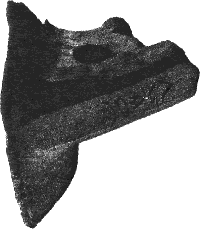 |
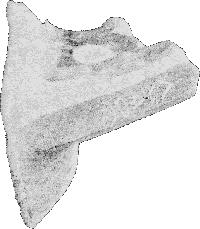 |
Table 7.2.16-1: The partial transcription of the Bilyar Relic βŋïøöüɣðʃəɛ
| Written with normalized Khazar Rovas font (RTL) |
 |
|
Common Turkic (Ogur) (RTL
transcription) |
lyd (shyd) /n...t...b (n...r...b) |
| IPA phonetic transcription (LTR transliteration) |
 |
| Translation from Ogur |
‘dream/noon’ (second part is undeciphered) |
It appears that the best match for a jar would be something connected with liquids and
consumption. The surviving part of inscription is its tail end, a punch line of the whole phrase.
The phrase was probably a rhymed couplet. In that line of thinking toş-/doş-/tuş-/duş- “to
fill” for the dysh would be quite suitable semantically and phonetically. The last word in
the phrase most likely, but not obligatory, is a verb. The last word b...t...n (b...r...n)
may have plenty of possibilities: bat- “to bathe”, bit-/büt- “starting, setting off”, “heal”,
bat “hurriedly”, bod “body, stature”, “color”, but “thigh, leg”, “treasure”,
böd “throne”, bedü- “grow”, bödi:- “to dance”, bar- “go, leave”, ber- “give”,
bur- “to smell, to steam”, bere: “length”, berü “here”, bedze “adorn”,
and quite a few more. The jar itself is some embodiment of /b/p...t/ “pot”. That choice gives
plenty of possibilities to the artisan poet to coin a ringing phrase that attracts buyers. For
example, “XXX... fill the pot”, “XXX... fill (to the rim) to give (present, for the road, etc)”, “XXX...
fill to grow” “XXX... fill to the (full) length”, etc.
Notably, the notion of “noon” is a
metaphorical from a metaphor, to “stop” > “stop to rest” > “stop for rest at noon” > “noon”,
its essence is not noon, but stop to have a rest, it is a long and winding way to find a
phonetical match conditioned on a supposition that the /sh/ can be altered to /ll/.
From the above examples it is clear that in addition to “noon”, such emendation opens a whole slate
of new possibilities, all of them unprovable |
174
|

